EnGenius Technologies EMD2 AC1300 Dual-Band Mesh AP User Manual
EnGenius Technologies AC1300 Dual-Band Mesh AP
User Manual

User Manual
Business Solutions
Wireless Managed Indoor Access Point
EMD2
version 1.0
2
IMPORTANT
To install this Access Point please refer to the
Quick Installation Guide included in the product packaging.
3
Chapter 1 Product Overview................................................... 4
Key Features/Introduction........................................................... 5
System Requirements / Package Contents .............................. 6
TechnicalSpecications...............................................................7
Physical Interface........................................................................... 9
Chapter 2 Before You Begin .................................................. 10
Computer Settings....................................................................... 11
Mounting the Access Point........................................................... 16
Chapter 3 Conguring Your Access Point.......................... 17
Default Settings............................................................................ 18
Chapter 4 Building a Wireless Network............................. 19
Access Point Mode....................................................................... 20
AP Mesh Mode............................................................................... 21
Chapter 5 Overview............................................................... 22
Overview........................................................................................... 23
Connections.................................................................................... 25
Chapter 6 Network ................................................................. 27
Basic/IP Settings/SpanningTree Settings............................. 28
Chapter 7 2.4 GHz & 5 GHz Wireless................................... 30
Wireless Settings........................................................................ 31
2.4 GHz/5 GHz Wireless Network........................................... 32
2.4GHz/5GHzSSIDProle......................................................32
Wireless Security.......................................................................... 33
Wireless Advanced..................................................................... 36
Guest Network Settings............................................................ 38
RSSI Threshold ...............................................................................39
Wireless MAC Filtering.................................................................40
Chapter 8 Management........................................................ 42
Management VLAN Settings.................................................. 43
Advanced Settings....................................................................... 44
TimeZone........................................................................................47
Auto Reboot Settings................................................................ 48
Wi-Fi Scheduler............................................................................... 49
Tools.................................................................................................. 50
Account/Firmware........................................................................ 53
Backup/Restore ............................................................................. 54
Log.................................................................................................... 56
Logout/Reset................................................................................. 57
Appendix ................................................................................. 58
FCC Interference Statement.................................................. 59
IC Interference Statement.................................................... 60
CE Interference Statement..................................................... 62
Table of Contents
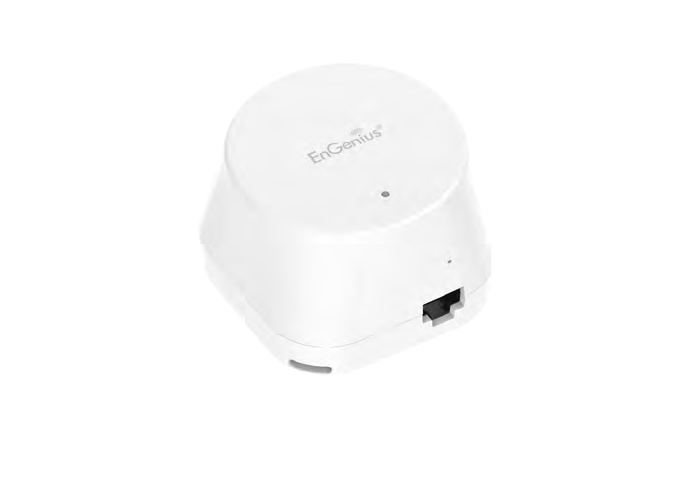
4
Chapter 1
Product Overview
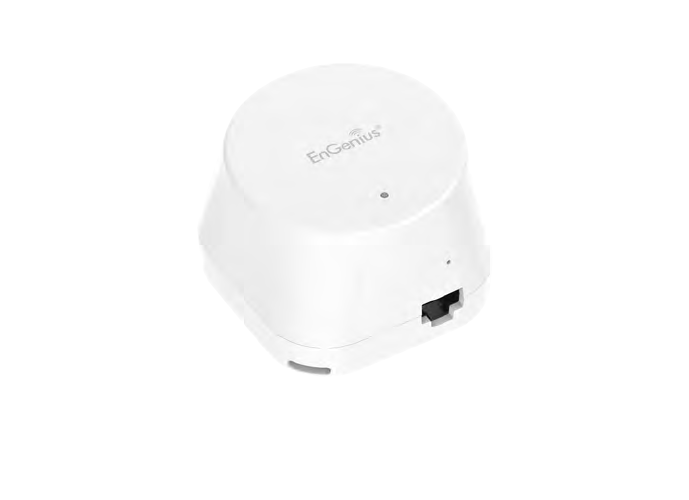
5
Maximum data rates are based on IEEE 802.11 standards. Actual throughput and range may vary depending on many factors including environmental conditions, distance between
devices, radio interference in the operating environment, and mix of devices in the network. Features and specications subject to change without notice. Trademarks and registered
trademarks are the property of their respective owners. For United States of America: Copyright © 2018 EnGenius Technologies, Inc. All rights reserved.
Key Features
> Dual radio 2x2 802.11 ac/a/b/g/n Access Point with multi-user MIMO
(MU-MIMO)
> Supportupto867Mbpsin5GHzfrequencybandand400Mbpsin
2.4GHz frequency band (with 2ss/VHT40 clients).
> Highpoweredamplierstoimprovethewirelesscoverageanduses
a special radio frequency pattern to increase its receiver sensitivity for
improved performance.
> Support 802.11ac Wave 2.0 technology to enhance overall bandwidth
and speed to wireless client devices.
> Systemic and distributed management over EnGenius ezMaster and
EWS Management switch without licensing or subscription fee.
> 360° omni-directional antennas to achieve comprehensive coverage
for networking client devices under a pervasive environment.
> Compliancewith802.3af&48VPoEInputforexibleinstallationover
100 meters (328 feet).
> Performone-clickupdatetodeliveracongurationovermulti-
segments for managed Access Points.
> Choose an operating mode to meet your management and deployment
requirement.
Introduction
EnGenius AP Dot (EMD2) is designed with a smaller size,
but provides highly AC1300 performance combine with
power plug. EMD2 also be built-in EnMesh™ wireless
link technology to extend Wi-Fi ranges throughout your
entire home or small ofce all the time.
Introduction - EMD2
To protect sensitive data during wireless transmissions,
the device offers different encryption settings for
wireless communications, including industry standard
WPA and WPA2 encryption. The AP also includes MAC
address ltering to allow network administrators to
provide network access only to known computers and
other devices based on their MAC addresses.
6
System Requirements
The following are the Minimum System Requirements in
ordercongurethedevice:
• Computer with an Ethernet interface or wireless network capability
• WindowsOS(XP,Vista,7,8),orMacOS,Linux-basedoperatingsystems
• Web-browsing application (i.e. Edge, Internet Explorer, Chrome, Firefox,
Safari, or another similar browser application)
Package Contents
The EMD2 package contains the following items (all items
mustbeinpackagetoissuearefund):
• EMD2 APdot Access Point
• Network Cable
• Bracket
• Screw Set
• Quick Installation Guide
.
7
Dimensions(WxDxH):
-62.5x62.5x52.7mm
Mounting:
- Wall mount (standard US/EU single gang wall jack)
Environment:
-Operatingtemperature:0°C~35°C
-Operatinghumidity:0%~90%typical
-Storagetemperature:-20°C~60°C
Wireless
OperatingMode:
AP Mode
Mesh AP Mode
AutoChannelSelection:
- Setting varies by regulatory domains
SSIDs:
- Supports up to 8 SSIDs per frequency band
VLAN Tag / VLAN Pass-through
Wireless Client List
GuestNetwork:
- Allocates a separate network segment for guest access within the same
WLAN
QoS:
- Supports 802.11e/WMM
Band Steering
Mobility:
- PMKSA support for fast roaming
Security:
- WEP encryption: 64/128/152-bit
- WPA/WPA2 Enterprise/PSK
- Hidden SSID
- MAC address ltering (up to 50 MAC)
RadioSpecication
DualConcurrentRadio:
-2.4GHz:802.11b/g/nwithmaxdatarateupto400Mbps
-5GHz:802.11a/n/acwithmaxdatarateupto867Mbps
TransmitPower:
- Max transmit power is limited by regulatory power
RadioChains/SpatialStreams:
-2x2:2
SupportedRadioTechnology:
-802.11b:Direct-SequenceSpread-Spectrum(DSSS)
-802.11a/g/n/ac:OrthogonalFrequency-DivisionMultiplexing(OFDM)
Channelization:
- 802.11ac with 20/40/80 MHz channel width
- 802.11n with 20/40 MHz channel width
- 802.11a/b/g with 20 MHz channel width
SupportedModulation:
-802.11b:BPSK,QPSK,CCK
-802.11a/g/n:BPSK,QPSK,16-QAM,64-QAM
-802.11ac:BPSK,QPSK,16-QAM,64-QAM,256-QAM
Supporteddatarates(Mbps):
-802.11b:1,2,5.5,11
-802.11a/g:6,9,12,18,24,36,48,54
-802.11n:6.5to400(MCS0toMCS15)
-802.11ac:6.5to867(MCS0toMCS9,NSS=1to2)
InternalAntenna:
- 2.2 dBi 2.4 GHz antennas
- 5.9 dBi 5 GHz antennas
Interface:
- 1 x 10/100/1000 Mbps Port
- 1 x Reset button
- 1 x DC in
Technical Specications - EMD2
8
Band Steering
Mobility:
- PMKSA support for fast roaming
Security:
-WEPencryption:64/128/152-bitSecurity:
-WEPencryption:64/128/152-bitLEDIndicator
- WPA/WPA2 Enterprise/PSK
- Hidden SSID
-MACaddressltering(upto50MAC)
- Client isolation
Management
Deployment Options
- Standalone Mode
- Managed Mode (by Neutron Switch or ezMaster)
Conguration
- Web Interface (HTTP)
- SNMP v1/v2c/v3 with MIB I/II and private MIB
- CLI (Telnet)
Firmware Upgrade
- Web interface or CLI (FTP/HTTP)
Backup / Restore Settings
- Revert to factory default settings
ScheduleReboot:
-Speciesintervaltorebootsystemperiodically
E-mailAlert/SyslogNotication
Technical Specications - EMD2
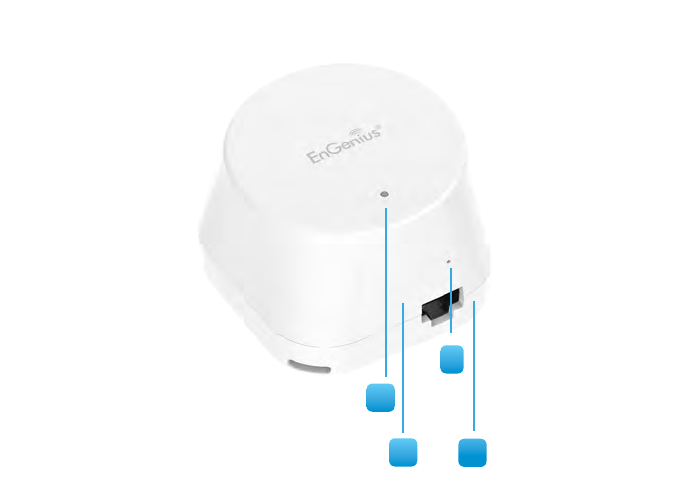
9
Physical Interface (EMD2)
Dimensions and Weights
62.5x62.5x52.7mm
1.LEDIndicators:LEDsforPower,5GHz,2.4GHzWirelessConnection,
Reset, Reboot.
2.ResetButton:Press,holdforover10secondstoresettofactory
default settings
3.10/100/1000LANPorts:RJ45accessports
4. DC Power in
1
2
3
4
1
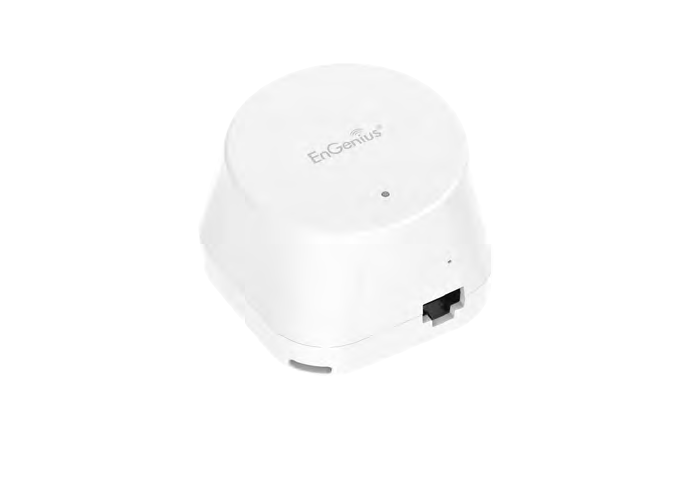
10
Chapter 2
Before You Begin
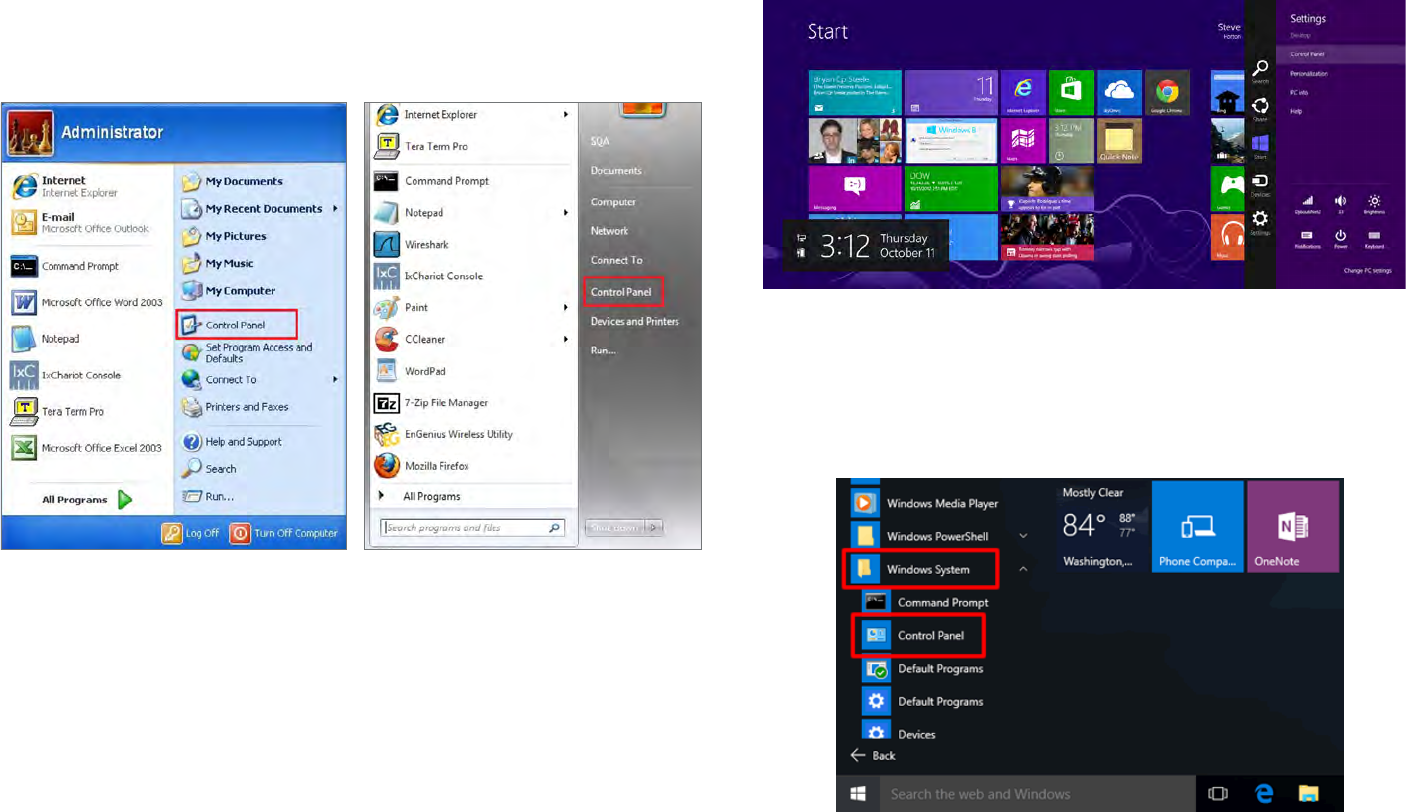
11
Windows XP/Windows 7/Windows 8/Windows
10
InordertousetheAccessPoint,youmustrstcongurethe
TCP/IPv4 connection of your Windows OS computer system.
1a. Click the Start button and open the Control Panel
1b. Move your mouse to the lower right hot corner to
display the Charms Bar and select the Control Panel in
Windows 8 OS.
1c. In Windows 10, click Start to select All APPs to enter
the folder of Windows system for selecting Control
Panel.
Computer Settings
Windows XP Windows 7
Windows 8
Windows 10
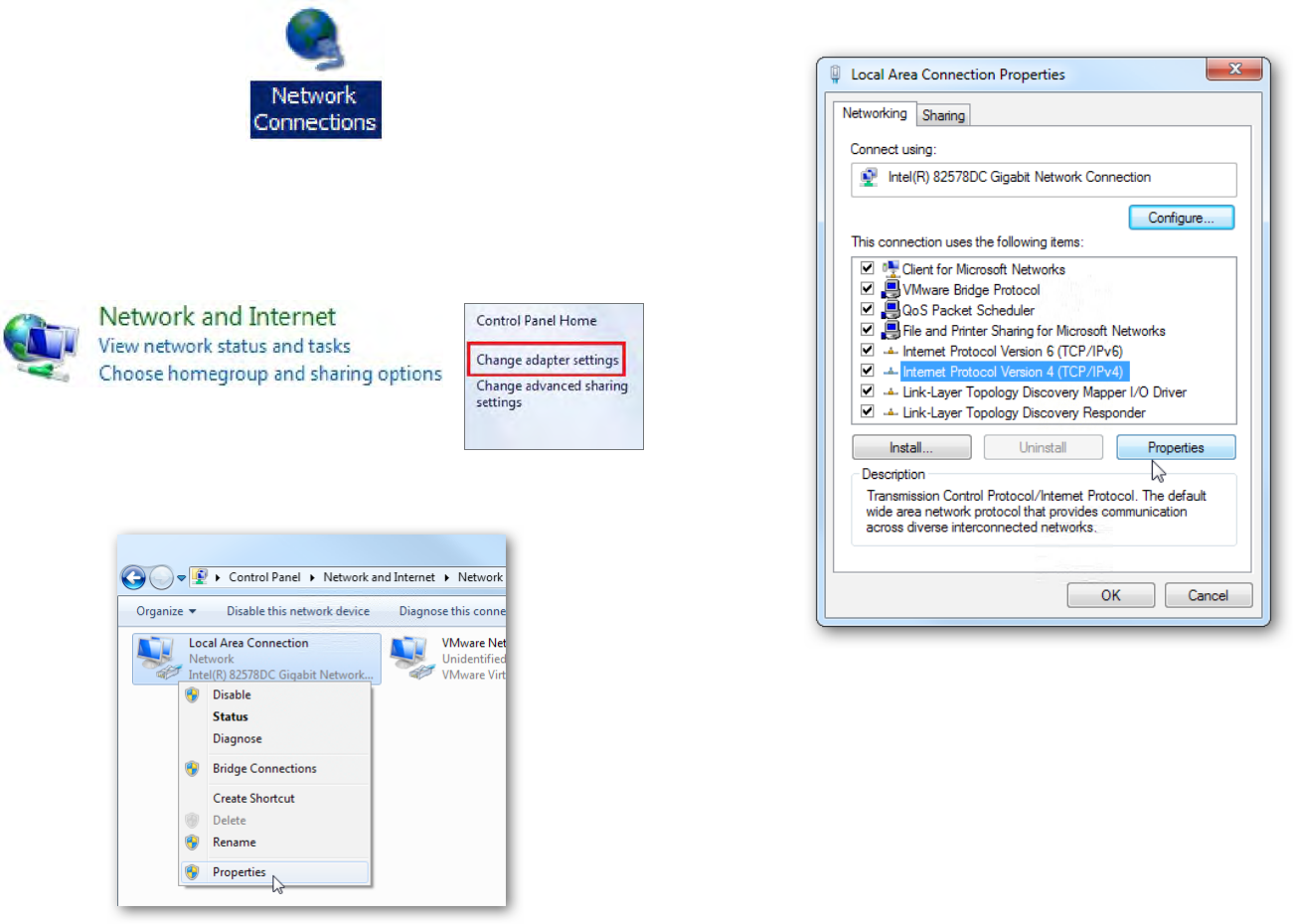
12
2a. In Windows XP, click Network Connections.
2b. In Windows 7/Windows 8/Windows 10, click View
Network Status and Tasks in the Network and
Internet section, then select Change adapter settings.
3. Right click on Local Area Connection and select Properties.
4. Select Internet Protocol Version 4 (TCP/IPv4) and then
select Properties.
5. Select Use the following IP address and enter an IP
address that is different from the Access Point and Subnet
mask, then click OK.
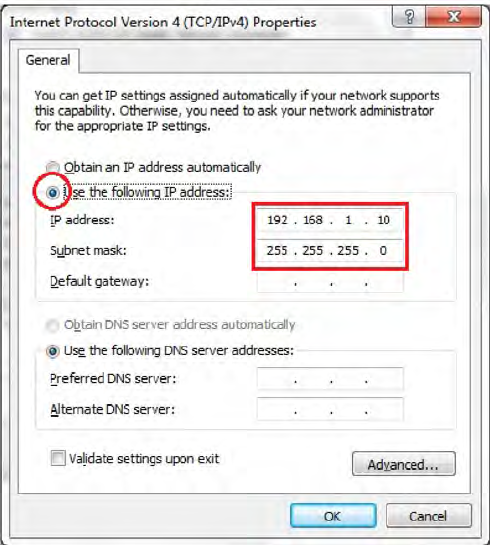
13
Note: Ensure that the IP address and Subnet mask are
on the same subnet as the device.
Forexample:APIPaddress:192.168.1.1
PCIPaddress:192.168.1.2–192.168.1.255
PCSubnetmask:255.255.255.0
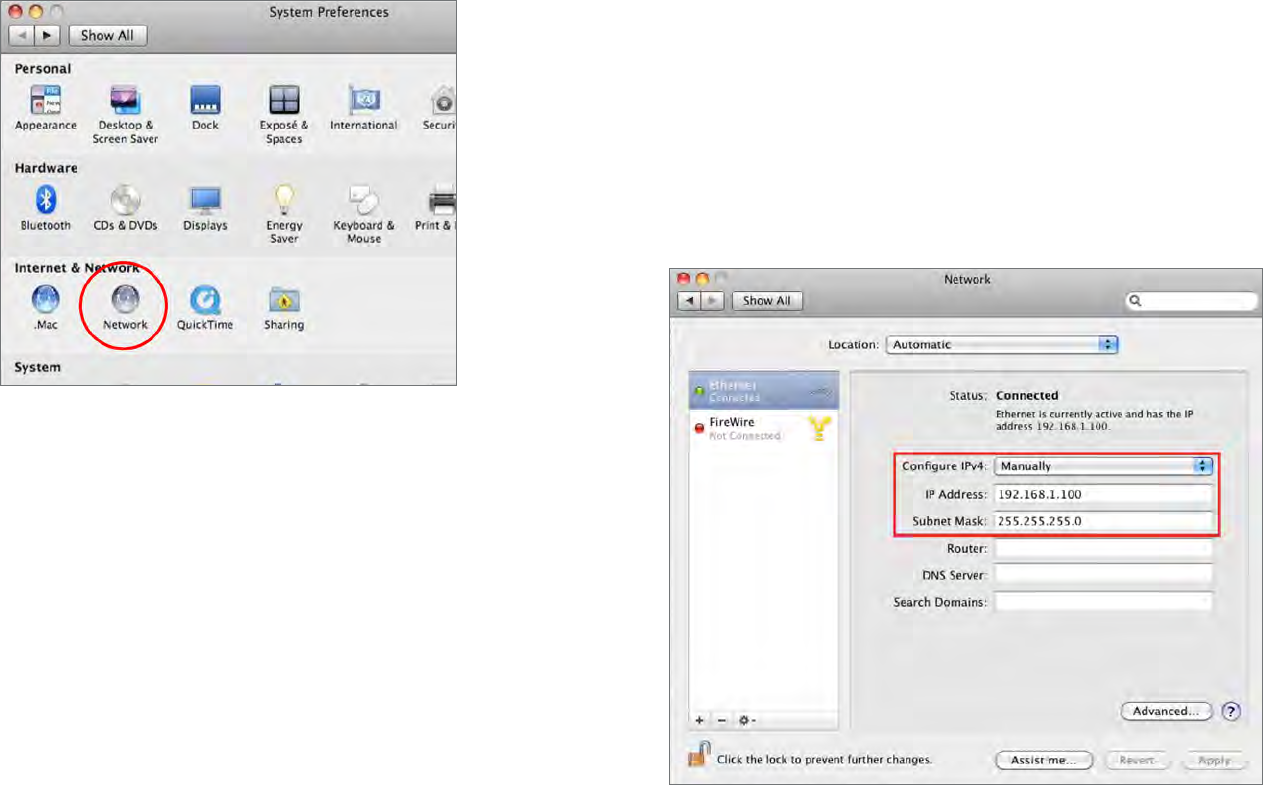
14
Apple Mac OS X
1. Go to System Preferences (Which can be opened in the
Applications folder or selecting it in the Apple Menu).
2. Select Network in the Internet & Network section.
3. Highlight Ethernet.
4. In Congure IPv4, select Manually.
5. Enter an IP address that is different from the Access
Point and Subnet mask then press OK.
Note: Ensure that the IP address and Subnet mask are
on the same subnet as the device.
Forexample:AdeviceIPaddress:192.168.1.1
PCIPaddress:192.168.1.2–192.168.1.255
PCSubnetmask:255.255.255.0
6. Click Apply when done.
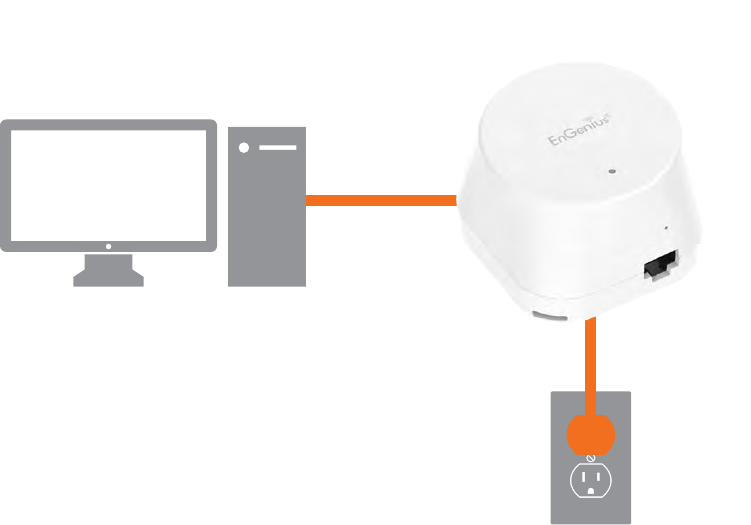
15
1. Ensure that the computer in use has an Ethernet
Controller port (RJ-45 Ethernet Port). For more
information, verify with your computer’s user manual.
2. Connect one end of the Category 5e Ethernet cable
intotheRJ-45portoftheEMD2andtheotherendto
theRJ-45portofthecomputer.Ensurethatthecableis
securely connected to the EMD2 and the computer.
3. Connect the EMD2 AP to ther to an available electrical
outlet. Once both connections are secure, verify the
following:
a) Ensure that the POWER light is on (it will be Blue).
b) Once all three lights are on, proceed to set up the
Access Point using the computer.
Hardware Installation
Ethernet
PC
Power
Outlet
16
Mounting the EMD2
1. Attach the mounting bracket to the ceiling / wall using the provided mounting kit.
2.Inserttheprovidedshortscrewsintothemountingholestoxthebrackettotheceiling/wall.
3. Check the align mark between unit and bracket in the right place. Then, the power and ethernet cable
can smoothly pass through the groove space.
4. Mount the access point to the bracket by rotating the unit clockwise about 45 degree to secure it in
place.
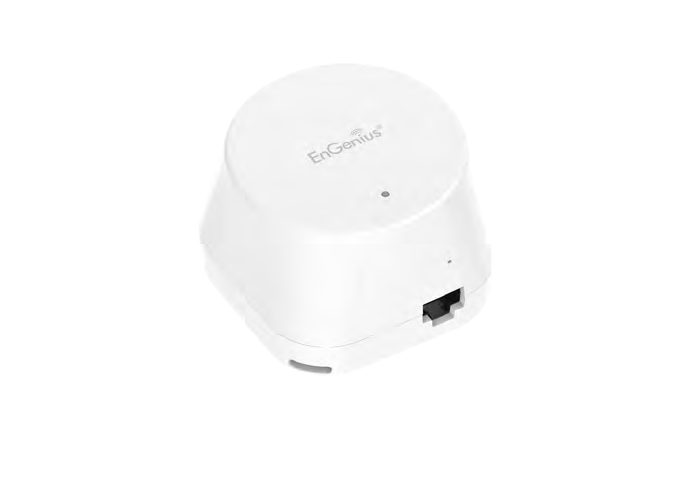
17
Chapter 3
Conguring Your Access Point
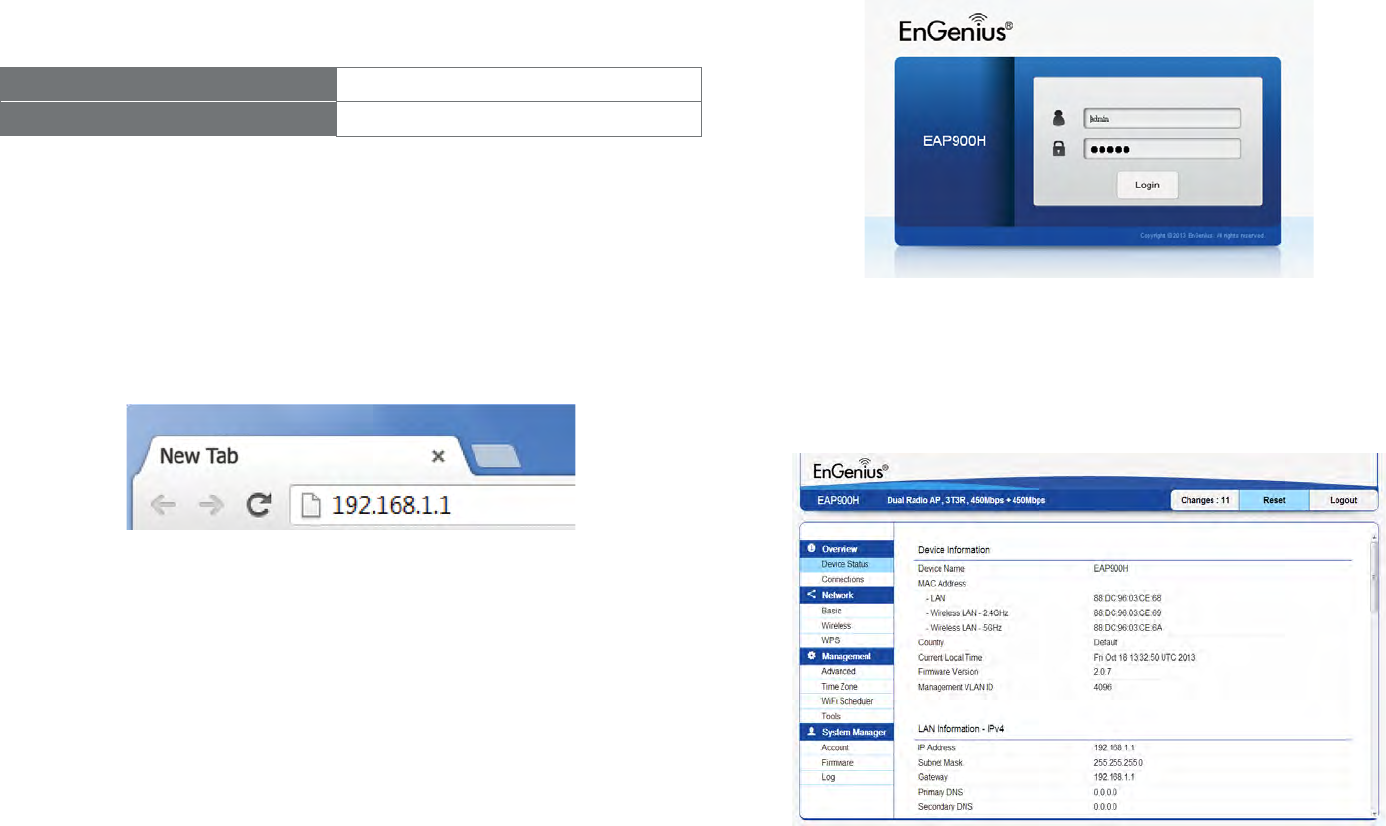
18
This section will show you how to congure the device
usingtheweb-basedcongurationinterface.
Default Settings
Please use your Ethernet port or wireless network adapter
to connect the Access Point.
IP Address 192.168.1.1
Username/Password admin/admin
Web Conguration
1. Open a web browser (Internet Explorer/Firefox/Safari)
and enter the IP Address http://192.168.1.1.
Note: If you have changed the default LAN IP Address of
the Access Point, ensure you enter the correct IP Address.
2. Thedefaultusernameandpasswordare:admin. Once
you have entered the correct username and password,
click the Login button to open the web-based
congurationpage.
* The model name will be varied in the web browser.
3. If successful, you will be logged in and see the EAP
User Menu.
Conguring Your Access Point
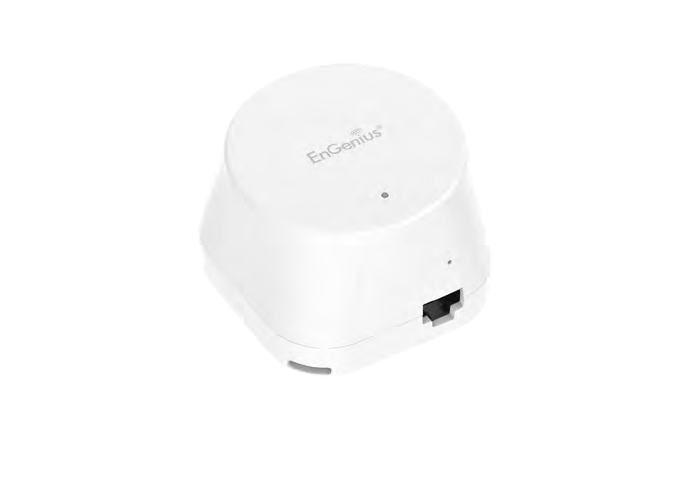
19
Chapter 4
Building a Wireless Network
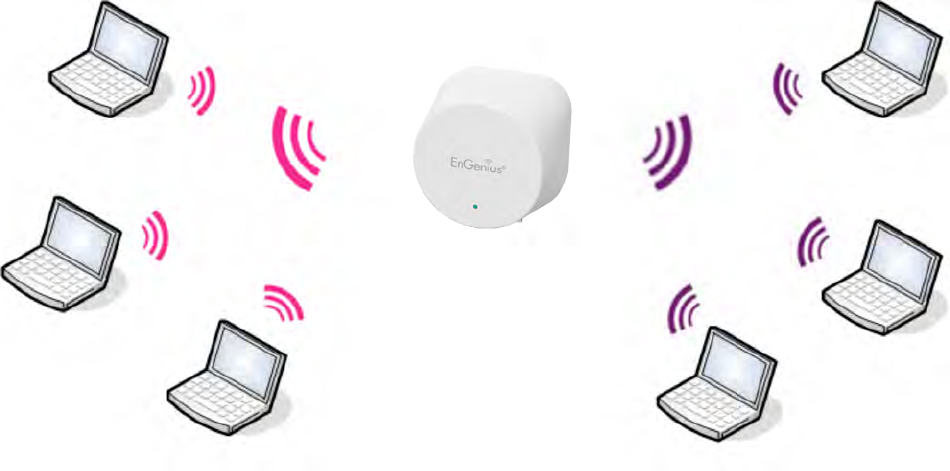
20
The EMD2 has the ability to operate in various modes. This chapter describes the operating modes of above two models.
Access Point Mode
In Access Point Mode, the EMD2 behaves like a central connection for stations or clients that support IEEE 802.11a/b/g/n
networks.ThestationsandclientsmustbeconguredtousethesameSSID(ServiceSetIdentier)andsecuritypasswordto
associate with the EMD2. The EMD2 supports up to eight (8) SSIDs per band (16 total) at the same time for secure access.
AP Mesh Mode
EMD2
Client
Client
Client Client
Client
Client
2.4 GHz 5 GHz
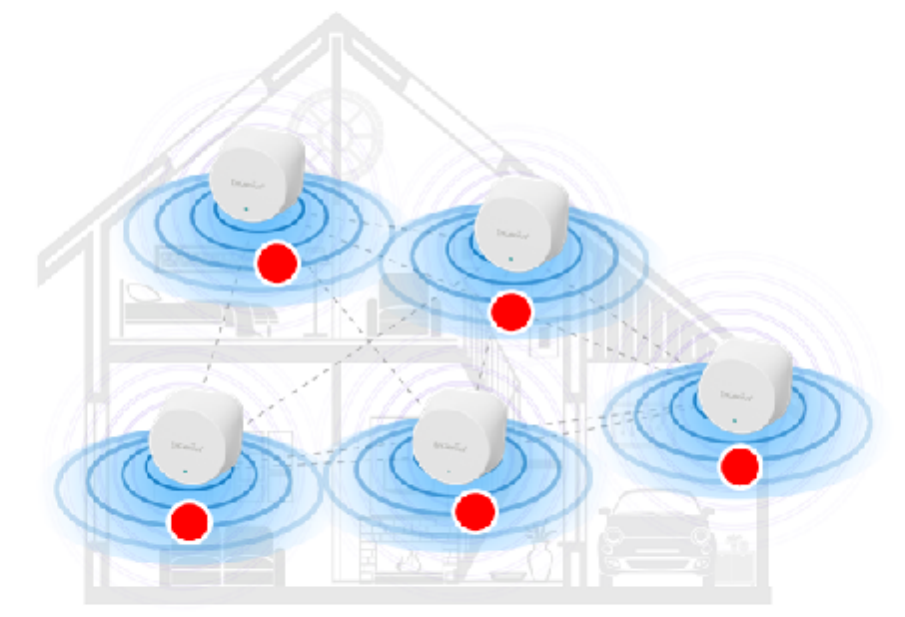
21
Under the AP Mesh mode, the EMD2 can be used as the central connection hub for station or clients that
supportIEEE802.11b/g/nnetwork.Underthismode,theEMD2canbeconguredwiththesameMeshSSIDandsecurity
password in order to associate with other EMD2, as well as connect with clients under the same SSID and encryption
signatures. For example, you would use one band to connect Access Points in range with Mesh mode and the other band
tobroadcasttrafconthenetwork.
WDS Bridge Mode
EMD2
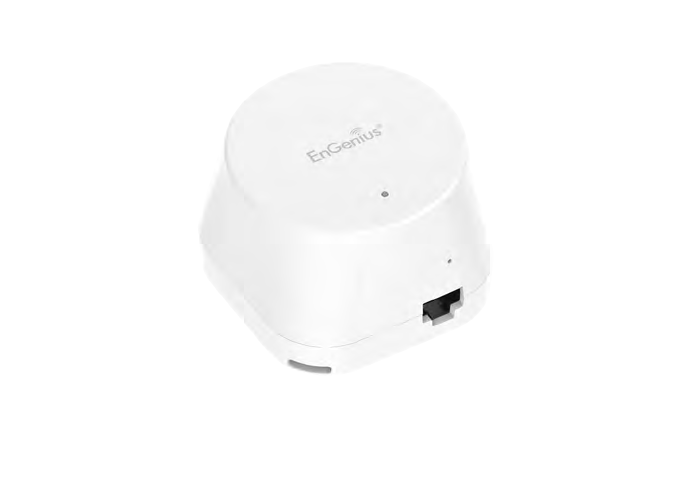
22
Chapter 5
Overview
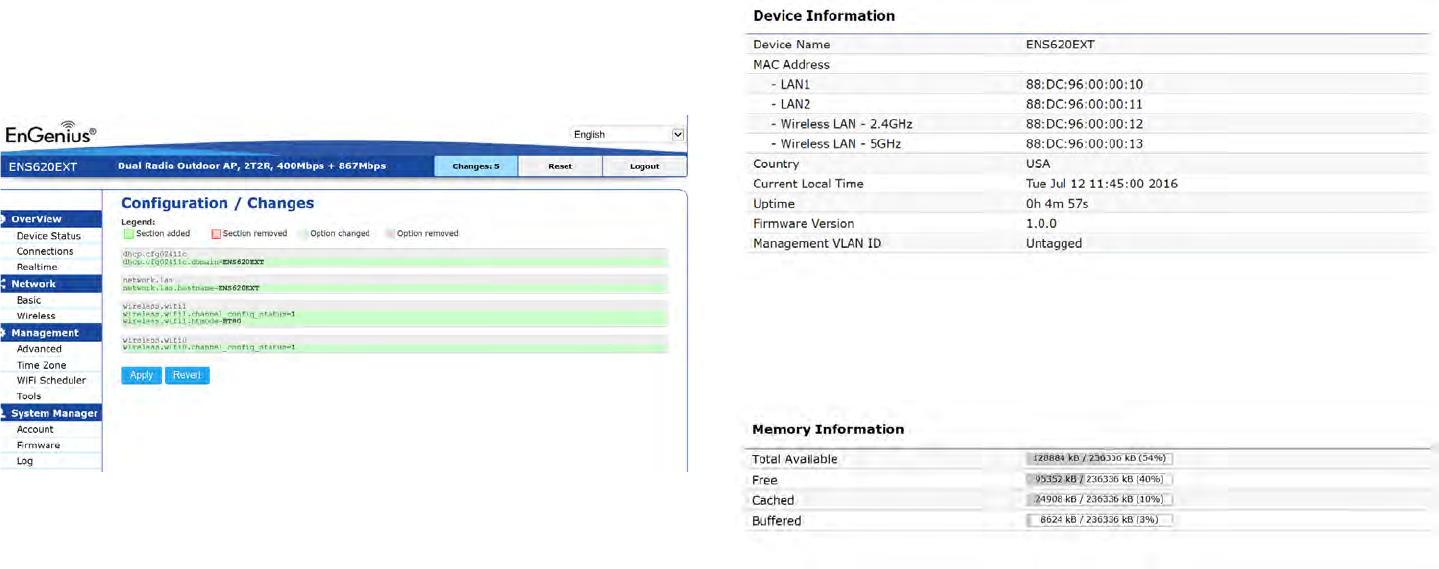
23
Save Changes
This page lets you save and apply the settings shown under
Unsaved changes list, or Revert the unsaved changes and
revert to the previous settings that were in effect.
Device Status
Clicking the Device Status link under the Overview menu
shows the status information about the current operating
mode.
• The Device Information section shows general system
information such as Device Name, MAC Address, Current
Time, Firmware Version, and Management VLAN ID
Note: VLAN ID is only applicable in Access Point, WDS
AP or WDS BR mode.
• The Memory Information section shows usage of
memory such as Total Available, Free, Cached, Buffered
Overview
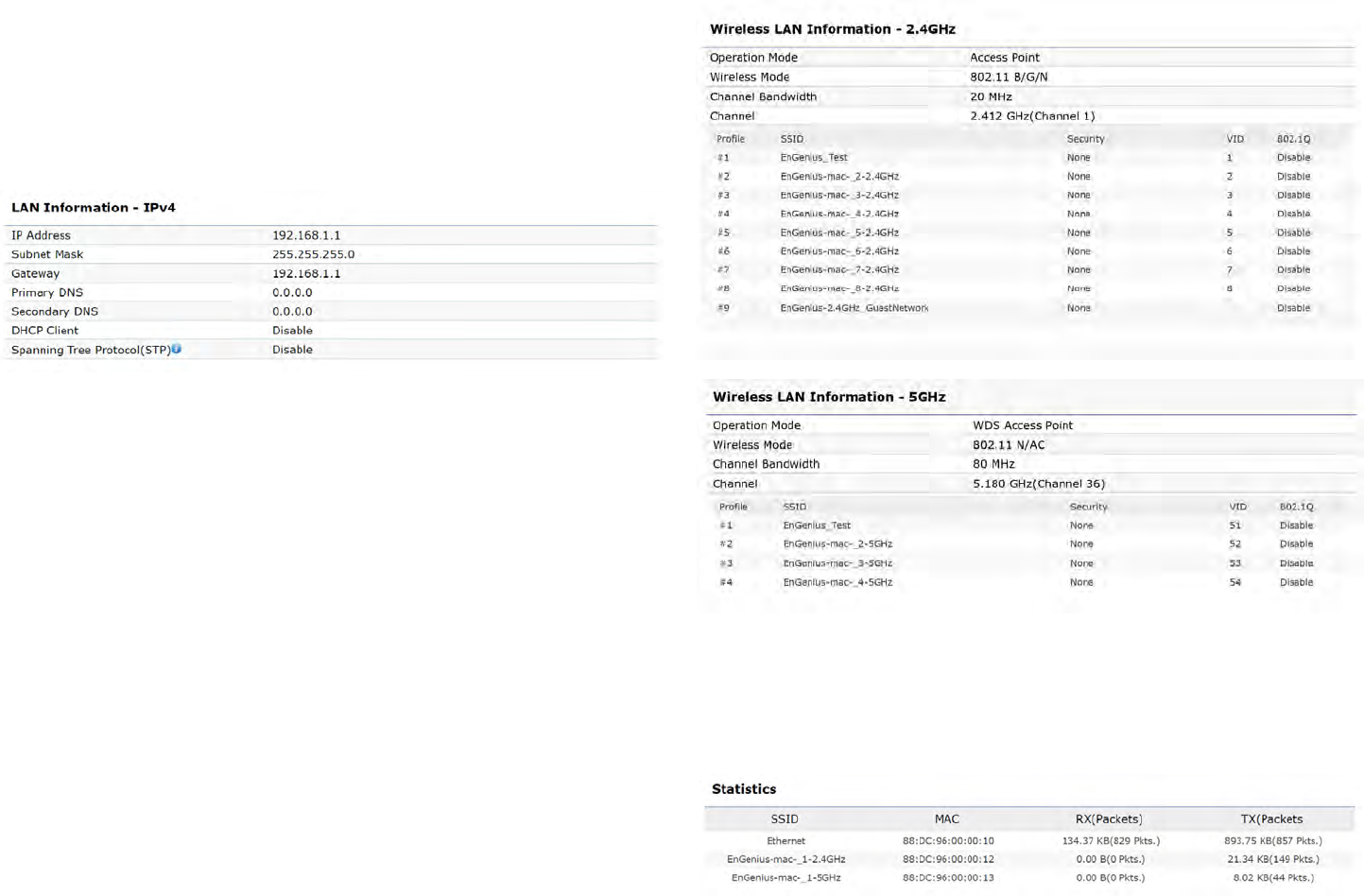
24
• The LAN Information section shows the Local Area
Network settings such as the LAN IP Address, Subnet
mask, Primary DNS Address, Secondary DNS Address,
status of DHCP client, and status of Spanning Tree
protocol (STP).
The Wireless LAN Information 2.4 GHz/5 GHz section
shows wireless information such as Operation Mode,
Frequency, and Channel. Since this Access Point supports
multiple-SSIDs, information about each SSID, the ESSID,
and security settings, are displayed
Note: ProleSettingsareonlyapplicableinAccessPoint
and WDS AP modes.
• The Statistics section shows Mac information such as
SSID, MAC address, RX and TX.
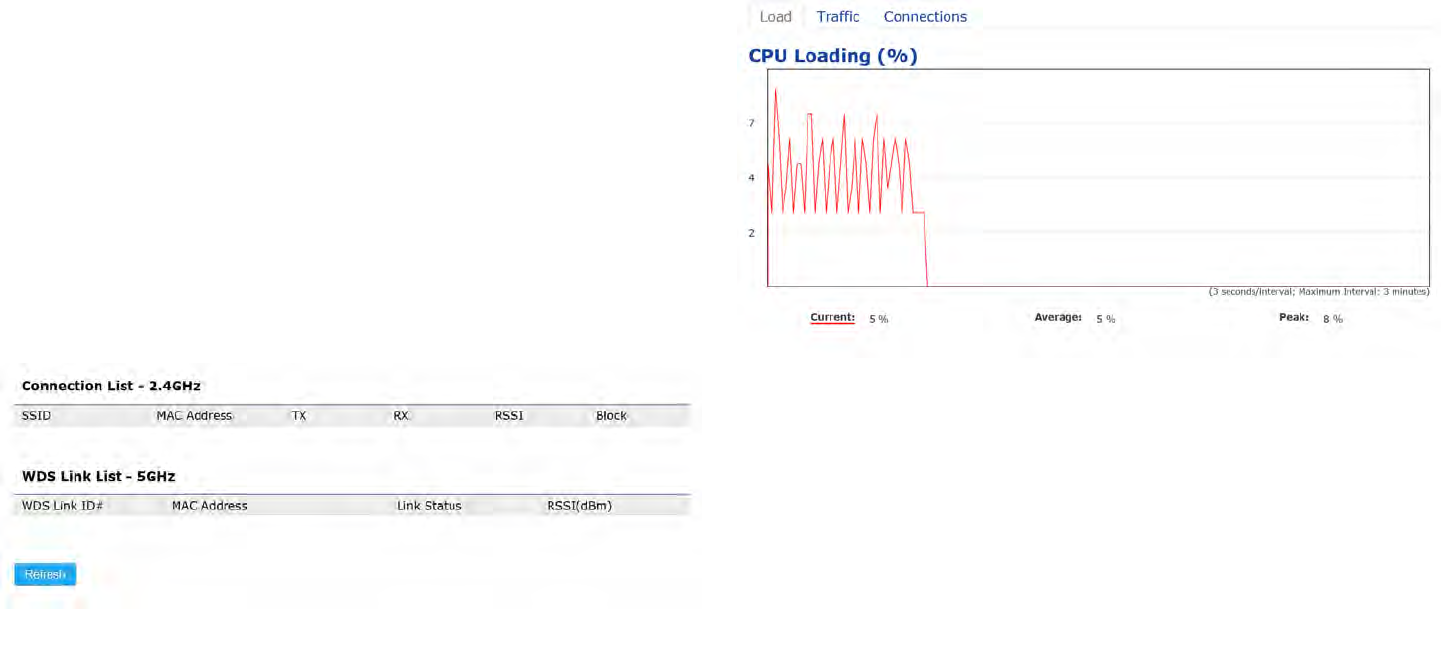
25
2.4 GHz/5 GHz Connection List
Click the connection link under the Overview menu displays
the connection list of clients associated to the AP’s 2.4
GHz/5 GHz, along with the MAC addresses and signal
strength for each client. Clicking Refresh updates the
client list.
Note: Only applicable in Access Point and WDS AP
modes.
2.4 GHz/5 GHz WDS Link List
Click the connection link under the Overview menu. This
page displays the current status of the WDS link, including
WDS Link ID, MAC Address, Link Status and RSSI.
Note: Only applicable in WDS AP and WDS Bridge modes.
Realtime
TheRealtimesectioncontainsthefollowingoptions:
CPU Loading: 3 minutes CPU loading percentage
information, it displays current loading, average loading
and peak loading status. Left bar is loading percentage;
button is time tracing. Interval is every 3 seconds
Connections Realtime
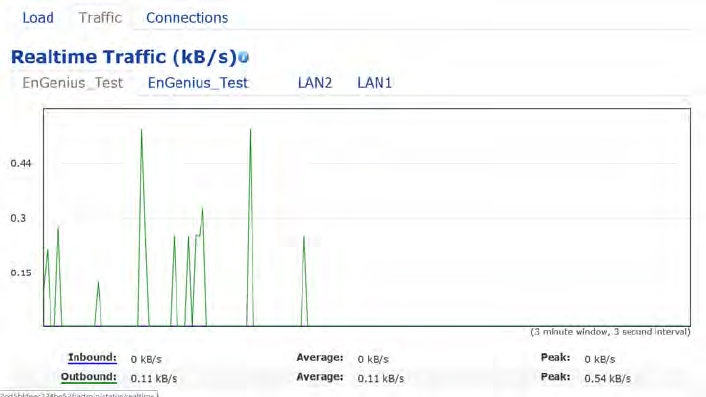
26
Trafc Loading: 2.4GHz and 5GHz and Ethernet port
inboundandoutboundtrafcbycurrent,averageand
peak time.
Realtime Connection (Pkts): Overview on current
active network connections. It displays UDP and TCP
packets information and other connection status. UDP
connections curve is in blue; TCP connection curve is
in green; others curve is in red. Below of chart shows
connections source and destination.
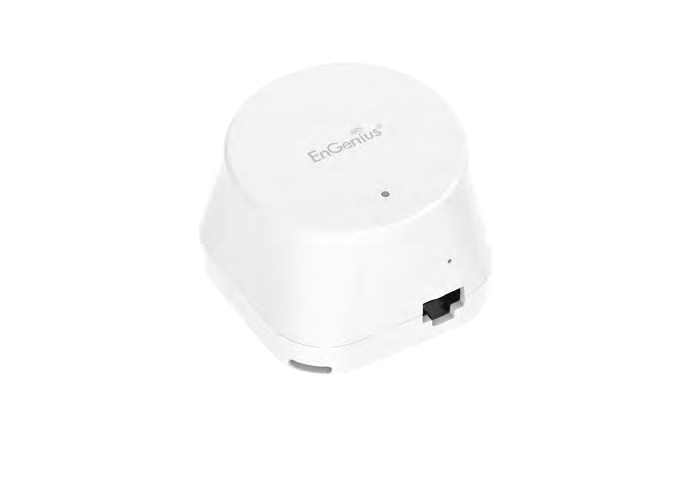
27
Chapter 6
Network
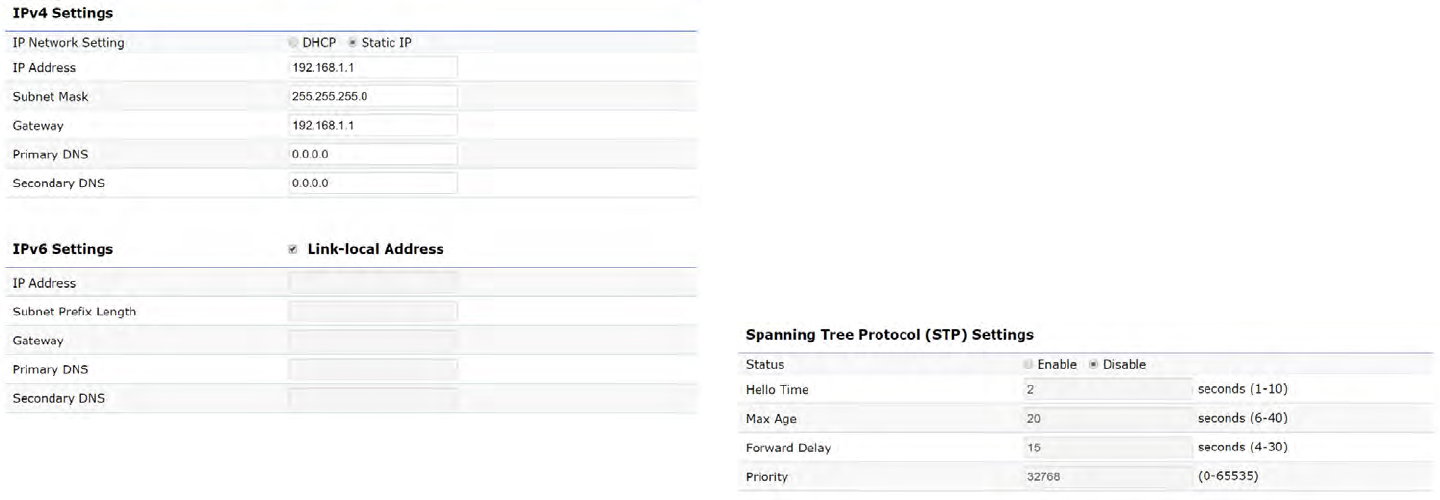
28
IPv4/IPv6 Settings
This page allows you to modify the device’s IP settings.
IP Network Settings: Select whether the device IP address
willuseastaticIPaddressspeciedintheIPaddresseld
or be obtained automatically when the device connects to
a DHCP server.
IP Address: The IP address of this device.
Subnet Mask: The IP Subnet mask of this device.
Gateway: The Default Gateway of this device. Leave it
blank if you are unsure of this setting.
Primary/Secondary DNS: The primary/secondary DNS
address for this device.
Save: Click Savetoconrmthechanges.
Spanning Tree Protocol (STP) Settings
This page allows you to modify the Spanning Tree settings.
Enabling the Spanning Tree protocol will prevent network
loops in your LAN network.
Spanning Tree Status:EnablesorDisablestheSpanning
Tree function. Default is Disable.
Hello Time: Species Bridge Hello Time in seconds. This
value determines how often the device sends handshake
packets to communicate information about the topology
throughout the entire Bridged Local Area Network.
Max Age: SpeciesBridgeMaxAgeinseconds.Ifanother
Basic
29
bridge in the spanning tree does not send a hello packet for
a long period of time, it is assumed to be inactive.
Forward Delay:SpeciesBridgeForwardDelayinseconds.
Forwarding delay time is the time spent in each of the
Listening and Learning states before the Forwarding state
is entered. This delay is provided so that when a new bridge
comesontoabusynetwork,itanalyzesdatatrafcbefore
participating in the network.
Priority: SpeciesthePriorityNumber.Asmallernumber
has a greater priority than a larger number.
Save: Click Savetoconrmthechanges.
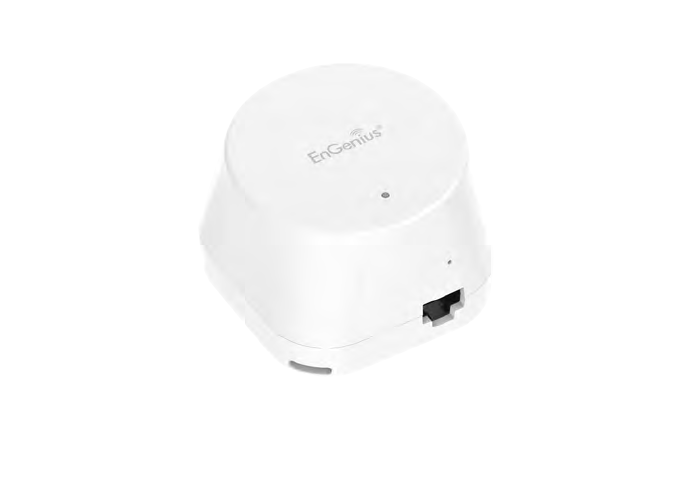
30
Chapter7
2.4 GHz & 5 GHz Wireless
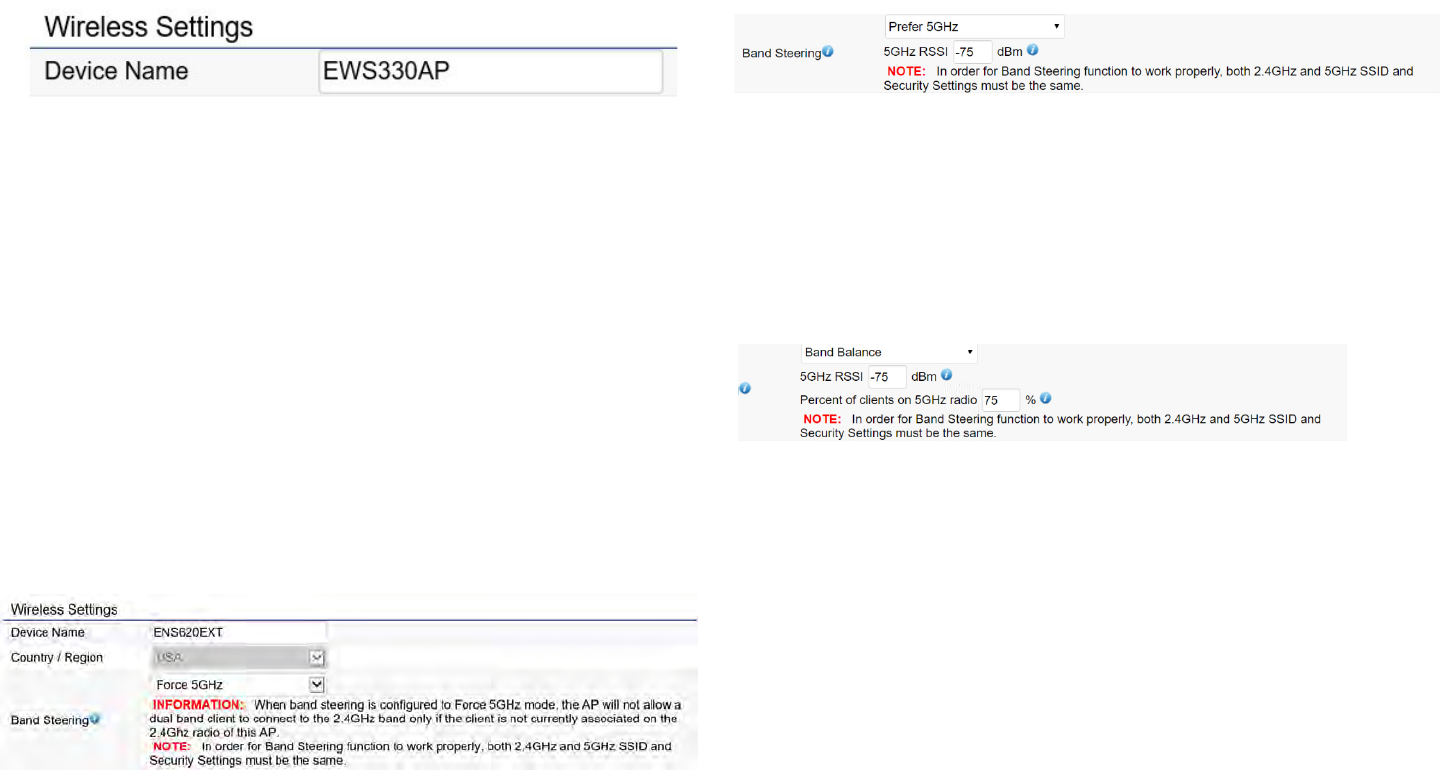
31
Wireless Settings
Device Name: Enter a name for the device. The name you
type appears in SNMP management. This name is not the
SSID and is not broadcast to other devices.
Band Steering: Enable Band Steering to send 802.11n
clients to the 5 GHz band, where 802.11b/g clients cannot
go, and leave 802.11b/g clients in 2.4GHz to operate at
their slower rates. Before implementing this feature, we
suggest you to assure the both 2.4GHz and 5GHz SSID,
as welll as security settings must be the same. EnGenius
Band Steering supports following advanced settings,
*Force 5GHz:WhenbandsteeringisconguredtoForce
5GHz mode, the AP will not dual band capable client
devices to network to the 2.4GHz band only if the client
devices are not currently associated on 2.4GHz radio in
this AP.
*Prefer 5GHz:WhenbandsteeringisconguredtoPrefer
5GHz mode, the AP will steer dual band capable client
devices to 5GHz radio when the RSSI value of these client
devices on 5GHz radio is more than set one. The allowed
RSSIvaluefordefaultsettingis-75dBm.
*Band Balance: When band steering is congured to
Band Balance mode, the AP will steer dual band capable
client devices to 5GHz when the RSSI value of these client
devices on 5GHz radio is more than set one. To evenly
allocate RF resource on the both 2.4GHz and 5GHz radios,
users also can set the portion of client devices on 5GHz
radio to assure smoothly connection. The default value of
the5GHzradiois75%.
Save: Click Savetoconrmthechanges.
Wireless
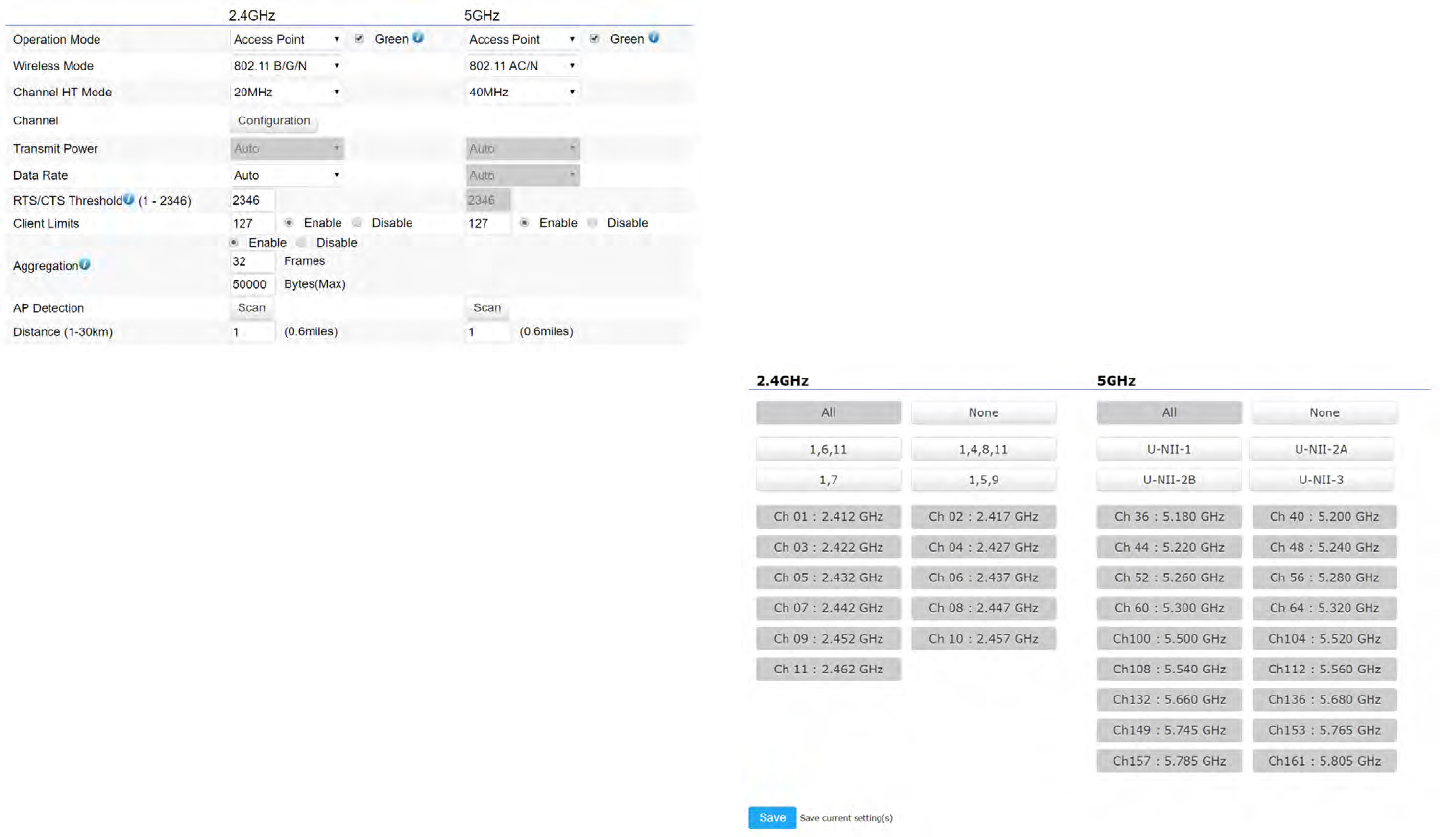
32
This page displays the current status of the Wireless
settings of this AP.
2.4 GHz/5 GHz Wireless Network
Operation Mode: Scrow down this list to select operation
modes for implementing on this radio. The default operation
mode is Access Point on base stations and Access Points
and is Client Bridge on Client Premise Equipements (CPE).
Meanwhile, EnGenius outdoor devices also support WDS
modes for peer to peer or peer to multi-peer connections.
Wireless Mode: Scrow down this list to select wireless
broadcasting standard on 2.4GHz and 5GHz frequency
bands.
Channel HT Mode: Scrow down this list to select bandwidth
for operating under a frequency band. The default channel
bandwidth is 20 MHz on 2.4GHz frequency radio and 40
MHz on 5GHz frequency radio. Considering the different
applications, users can decide to implement a channel
bandwidthtofulllrealapplications.Thelargerthechannel,
the greater the transmission quality and speed.
Transmit Power (Tx Power): Default Tx power is Auto
to obey regulartory power of each country.
Channel: Click Configuration button to open a new
windows to configure channels for performing wireless
service.
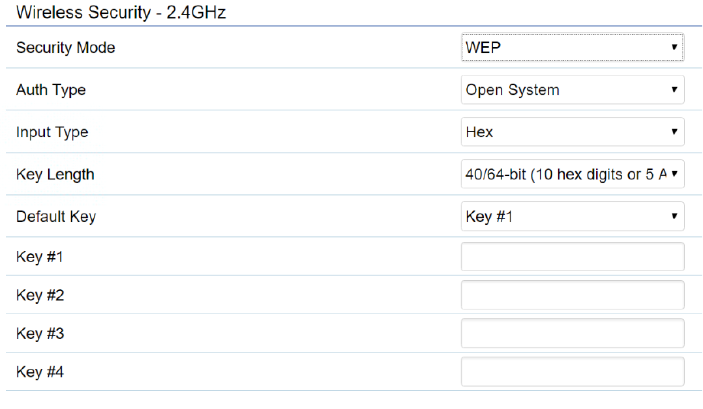
33
Wireless Security
TheWirelessSecuritysectionletsyouconguretheAP’s
security modes
Secuirty Mode: Including WEP, WPA-PSK, WPA2-PSK,
WPA-PSK Mixed, WPA, WPA2, and WPA Mixed. We strongly
recommend you to use WPA2-PSK mode.
* Setting of WEP mode:
Auth Type: Select Open System or Shared Key.
Input Type:
ASCII:RegularText(recommended)
Hexadecimal Numbers (For advanced users)
Key Length: Select the desired option and ensure that
wireless clients use the same setting. Your choices are 64,
128, and 152-bit password lengths.
Default Key: Select the Key you wish to be the default.
Transmitted data is ALWAYS encrypted using the Default
Key; the other Keys are for decryption only. You must enter
a Key Value for the Default Key.
Encryption Key Number: Enter the Key Value or values you
wish to use. Only the Key selected as Default is required.
The others are optional.
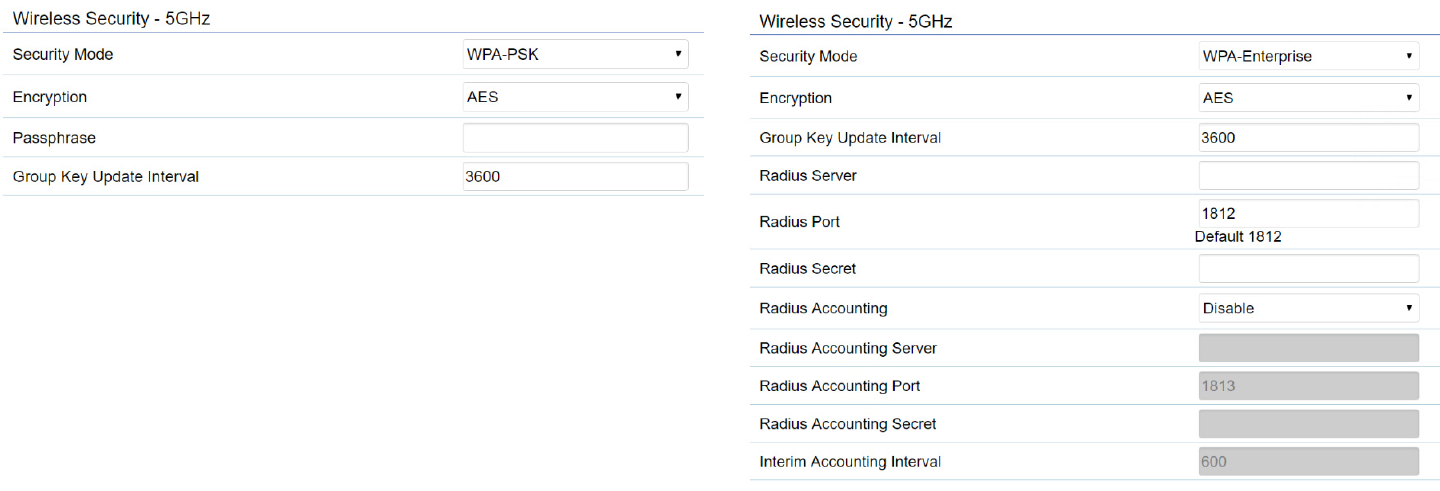
34
* Setting of WPA-PSK, WPA2-PSK and WPA-PSK Mixed
(Pre-Shared Key):
Encryption:YoumayselectAES,TKIPorBoth(TKIP+AES)
to be the encryption type you would like. Please ensure
that your wireless clients use the same settings.
Passphrase: Wireless clients must use the same Key to
associate the device. If using ASCII format, the Key must
be from 8 to 63 characters in length. If using HEX format,
the Key must be 64 HEX characters in length.
Group Key Update Interval: Species how often, in
seconds, the Group Key changes. The default value is 3600.
*
* Setting of WPA-Enterprise & WPA2-Enterprise (Pre-
Shared Key):
Encryption: Select the WPA encryption type you would like.
Please ensure that your wireless clients use the same settings.
Radius Server: Enter the IP address of the Radius server.
Radius Port: Enter the port number used for connections
to the Radius server.
35
Radius Secret: Enter the secret required to connect to the
Radius server.
Radius Accounting: Enable or disable accounting feature.
Radius Accounting Server: Enter the IP address of the
Radius accounting server.
Radius Accounting Port Enter the port number used for
connections to the Radius accounting server.
Radius Accounting Secret: Enter the secret required to
connect to the Radius accounting server.
Interim Accounting Interval: Species how often, in
seconds, the accounting data sends.
Note: 802.11n does not allow WEP/WPA-PSK TKIP/
WPA2-PSK TKIP security mode. The connection mode
will automatically change from 802.11n to 802.11g.

36
Wireless Advanced
Wireless Trafc Shaping
Trafc shaping regulates the ow of packets leaving an
interface to deliver improved Quality of Service.
Enable Trafc Shaping:Defaultisdisable.Youmaycheck
thisoptiontoenableWirelessTrafcShapingperSSID.
Download Limit: Speciesthewirelesstransmissionspeed
used for downloading.
Upload Limit: Species the wireless transmission speed
used for uploading.
Per User: Check this option to enable wireless trafc
shaping per user function. This function allow users to limit
the maximum download / upload bandwidth for each client
devices on this SSID.
Save: Click Savetoconrmthechanges.

37
Fast Roaming
Enable the function to serve mobile client devices that roam
from Access Point to Access Point. Some applications running
on Client devices require fast re-association when they roam
to a different Access Point
Please enter the settings of the SSID and initialize the Security
mode to WPA enterprise, as well as to set the Radius Server
rstly.UserscanenabletheFastRoamingandimplementthe
advanced search.
Please also set the same enterprise Encryption under
the same SSID on other Access Points and enable the
Fast Roaming. When the conguration is realized on
different Access Point, the mobile client devices can run
the voice service and require seamless roaming to prevent
delay in conversation from Access Point to Access Point.
Enable Fast Roaming: Enable or disable fast roaming
feature.
Enable Advanced Search: Enable or disable advanced
search feature.
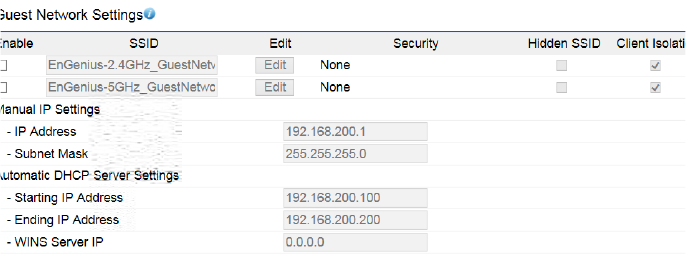
38
Adding a guest network to allow visitors to use the internet
withoutgivingoutyourofceorcompanywirelesssecurity.
You can add a guest network to each wireless network in
the 2.4GHz frequencies and 5GHz frequencies.
SSID: Specied the SSID for the current prole.. Choices
givenare:Disabled,DenyMACinthelist,orAllowMACin
the list.
Hidden SSID: Check this option to hide SSID from clients, If
checked, this SSID will not appear in the AP detect.
Client Isolation: Click the appropriate radio button to allow
or prevent communication between client devices.
IP address: The IP Address of this device.
Subnet Mask: The IP Subnet mask of this device.
Starting IP Address: TherstIPAddressintherangeof
the addresses by the DHCP server.
Ending IP Address: The last IP Address in the range of
addresses assigned by the DHCP server.
Guest Network Settings

39
Enable : Enable the Fast Handover feature by ensuring that
each client is served by at least one Access Point at any
time. Access Points continuously monitor the connectivity
quality of any client in their range and efciently share
this information with other Access Points in the vincinity
of that client to coordinate which of them should serve the
client best.
RSSI: Enter the RSSI (Received Signal Strength Index) in
order to determine the handover procedure which the
current wireless link will terminate. RSSI is an indication of
the power level being received by the antenna. Therefore,
the higher the RSSI number, the stronger the signal.
RSSI Threshold

40
Wireless MAC Filtering is used to allow or deny network
access to wireless clients (computers, tablet PCs, NAS,
smartphones, etc.) according to their MAC addresses. You
can manually add a MAC address to restrict permission to
accessEAP1750H.Thedefaultsettingis:Disable Wireless
MAC Filter.
Note: Only applicable in Access Point and WDS AP mode.
ACL (Access Control List) Mode: Determines whether
network access is granted or denied to clients whose MAC
addresses appear in the MAC address table on this page.
Choicesgivenare:Disabled,DenyMACinthelist,orAllow
MAC in the list.
MAC Address: Enter the MAC address of the wireless client
youwishtocongurefor.
Add: Click Add to add the MAC address to the MAC Address
table.
Delete: Deletes the selected entries.
Save: Click Save to apply the changes.
Wireless MAC Filtering
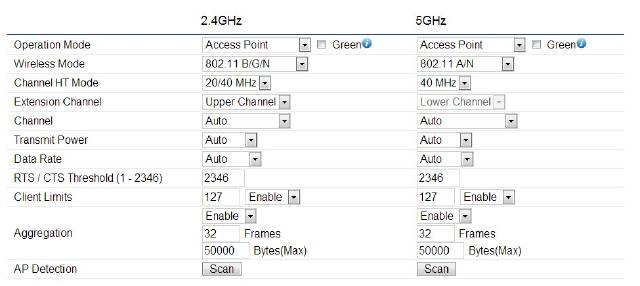
41
This page allows you to congure advanced wireless
settings for the EWS550AP/EWS510AP/EWS511AP. It is
recommended that the default settings are used unless
the user has experience with more advanced networking
features.
2.4 GHz/5 GHz Wireless Advanced
Data Rate: Select a data rate from the drop-down list. The
data rate affects throughput of data in the EAP1750H.
The lower the data rate, the lower the throughput, though
transmission distance will be lowered as well.
Transmit Power: Sets the power output of the wireless
signal.
RTS/CTS Threshold:Speciesthethresholdpackagesize
for RTC/CTS. A smaller number causes RTS/CTS packets to
be sent more often and in turn consumes more bandwidth.
Distance: Species the distance between Access Points
and clients. Longer distances may drop high-speed
connections.
Aggregation: Merges data packets into one packet. This
option reduces the number of packets, but increases packet
sizes.
Save: Click Savetoconrmthechanges.
Wireless Advanced
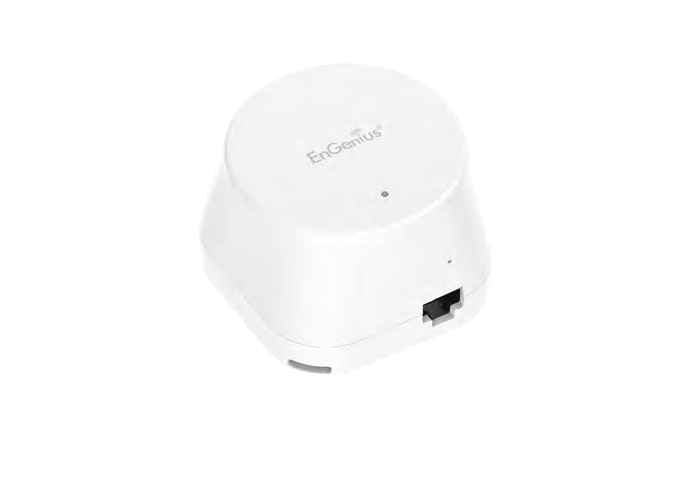
42
Chapter 8
Management

43
Management VLAN Settings
This page allows you to assign a VLAN tag to packets sent
over the network. A VLAN is a group of computers on a
networkwhosesoftwarehasbeenconguredsothatthey
behave as if they were on a separate Local Area Network
(LAN). Computers on VLAN do not have to be physically
located next to one another on the LAN.
Note: Only applicable in Access Point and WDS AP
modes.
Management VLAN:IfyournetworkincludesVLANs,you
can enable Management VLAN ID for packets passing
through the Access Point with a tag.
Save: Click SavetoconrmthechangesorCancel to cancel
and return to previous settings.
Note: IfyoureconguretheManagementVLANID,you
may lose your connection to this AP. Verify that the
DHCP server supports the recongured VLAN ID and
then reconnect to this AP using the new IP address.
MGMT VLAN Settings
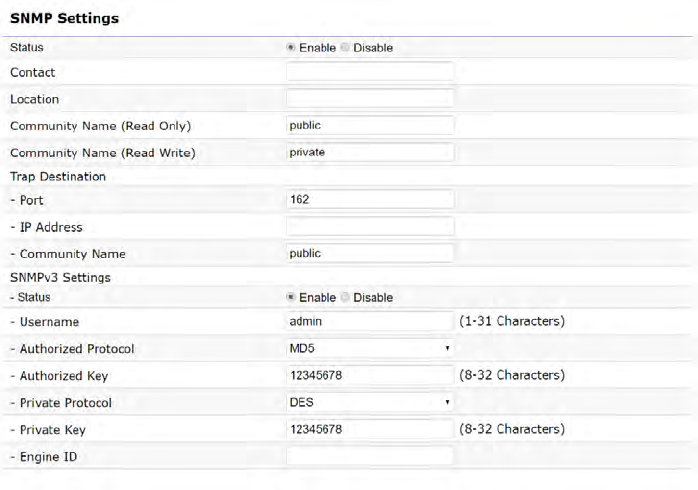
44
SNMP Settings
This page allows you to assign the Contact Details, Location,
Community Name, and Trap Settings for a Simple Network
Management Protocol (SNMP). SNMP is a networking
management protocol used to monitor network attached
devices. SNMP allows messages (called protocol data units)
to be sent to various parts of the network. Upon receiving
these messages, SNMP compatible devices (called agents)
returns the data stored in their Management Information
Bases.
SNMP Enable/Disable:EnablesordisablestheSNMP
feature.
Contact: Speciesthecontactdetailsofthedevice.
Location: Speciesthelocationofthedevice.
Community Name (Read Only): Speciesthepassword
for the SNMP community for read only access.
Community Name (Read/Write):Speciesthepassword
for the SNMP community with read/write access.
Trap Destination Address:SpeciestheIPaddressofthe
computer that will receive the SNMP traps.
Trap Destination Community Name: Speciesthe
password for the SNMP trap community.
SNMPv3: Enables or disables the SNMPv3 feature.
User Name:SpeciestheusernameforSNMPv3.
Auth Protocol:Selectstheauthenticationprotocoltype:
MDS or SHA.
Auth Key: Speciestheauthenticationkey.
Priv Protocol:Selectstheprivacyprotocoltype:DES.
Priv Key: Speciestheprivacykeyforprivacy.
Advanced Settings
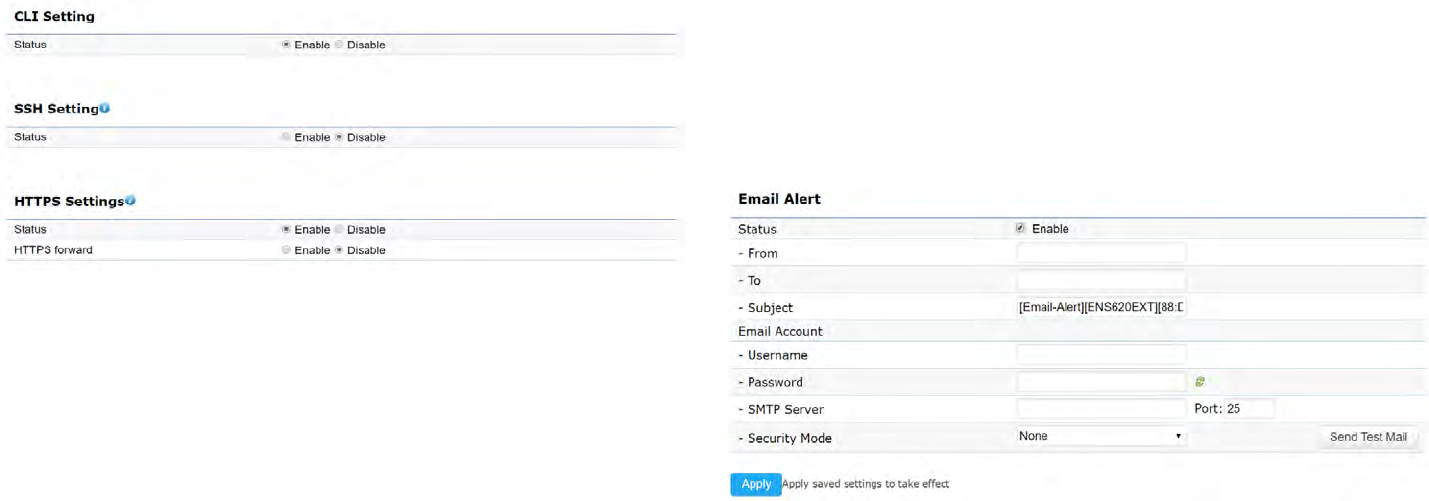
45
Engine ID: SpeciestheengineIDforSNMPv3.
Apply Save: Click Apply Save to apply the changes.
CLI Settings
CLI:TheCommandLineInterface(CLI)allowsyoutotype
commands instead of choosing them from a menu or
selecting an icon.
SSH:EnableSecureShell(SSH)tomakesecure,encrypted
connections in the network. Secure Shell is a network
protocol that allows data to be exchanged using a secure
channel between two network devices.
HTTPS: Enable HTTPS to transfer and display web content
securely. The Hypertext Transfer Protocol over SSL (Secure
Socket Layer) is a TCP/IP protocol used by web servers to
transfer and display web content securely.
Email Alert
You can use the Email Alert feature to send messages
to the congured email address when particular system
events occur.
Note:DoNOT use your personal email address as it can
unnecessarily expose your personal email login credentials.
Use a separate email account made for this feature instead
Status: Enable this function for further settings.
From: Enter the email address to show the sender of the
email.
To: Enter the address to receive email alerts.
Subject: Enter the text to appear in the email subject line.
46
Username: Enter the username for the email account that
will be used to send emails.
Password: Enter the password for the email account that
will be used to send emails.
SMTP Server: Enter the IP address or hostname of the
outgoing SMTP server.
Port: Enter the SMTP port number to use for outbound
emails.
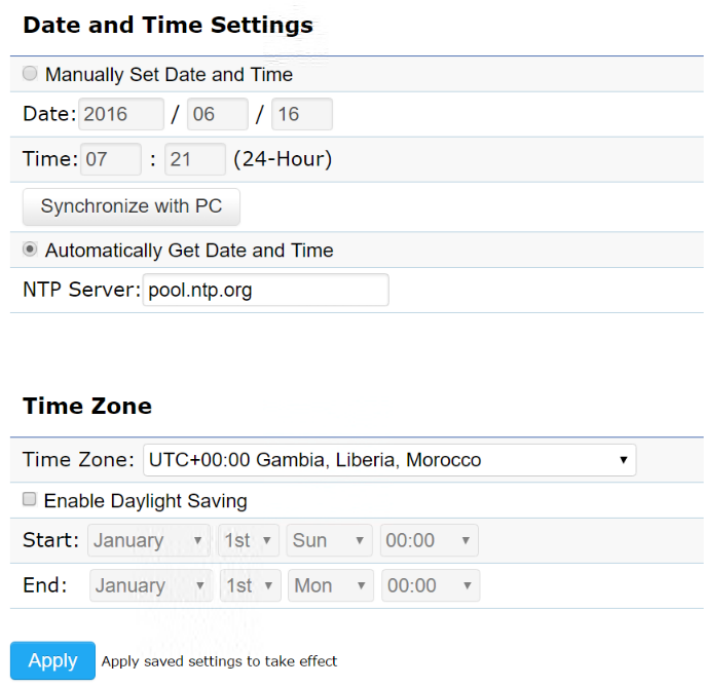
47
Time Setting
This page allows you to set the internal clock of the AP. Manually Set Date and Time: Manually specify the
date and time.
Synchorize with PC:Clickthisbuttontosynchorize
Date and time of this AP with the PC.
Automatically Get Date and Time: Select
Automatically Get Date and Time and check whether
you wish to enter the IP address of an NTP server or
use the default NTP server to have the internal clock
set automatically.
Time Zone: Choose a time zone to implement the
service for this AP.
Enable Daylight Saving:Checkwhetherdaylight
savings applies to your area.
Start:Selecttheday,month,andtimewhendaylight
savings time starts.
Enable Daylight Saving:Selecttheday,month,andtime
when daylight savings times ends.
Time Zone

48
Auto Reboot Settings
You can specify how often you wish to reboot the AP.
Auto Reboot Setting: Enables or disables the Auto
Reboot function.
Timer:Selectthedayandenterthetimeyouwouldlike
to reboot automatically.
Save:ClickSave to apply the changes.
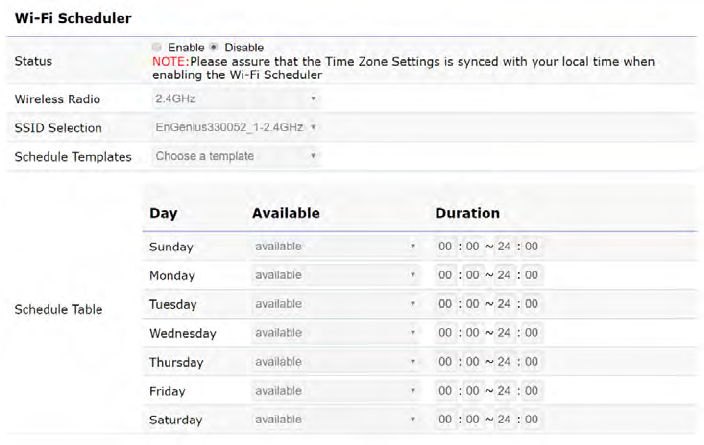
49
Wi-Fi Scheduler
The Wi-Fi Scheduler can be created for use in enforcing
rules. For example, if you wish to restrict web access to
Mon-Fri from 3pm to 8pm, you could create a schedule
selecting Mon, Tue, Wed, Thu and Fri while entering a Start
time of 3pm and End Time of 8pm to limit access to these
times.
Status: Enables or disables the Wi-Fi scheduler function.
Wireless Radio: Select 2.4 GHz or 5 GHz from the drop-
down list for the preferred band type.
SSID Selection: Select a SSID from the drop-down list.
Schedule Templates: Select a schedule template from the
drop-down list.
Day(s): Place a checkmark in the boxes for the desired days
or select the All Week radio button to select all seven days
of the week.
Duration:TheStartTimeisenteredintwoelds.Therst
box is for hours and the second box is for minutes. The End
Time is entered in the same format as the Start time.
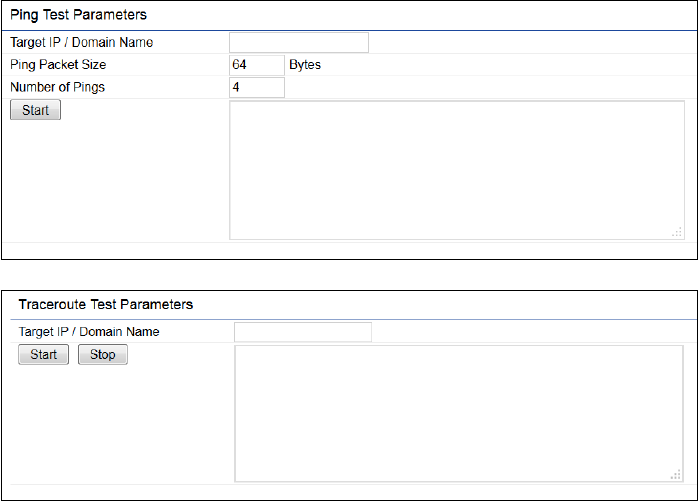
50
Ping Test Parameters
This page allows you to analyze the connection quality
of the AP and trace the routing table to a target in the
network.
Target IP: Enter the IP address you would like to search.
Ping Packet Size: Enter the packet size of each ping.
Number of Pings: Enter the number of times you wish to
ping.
Start Ping: Click Start Ping to begin pinging the target
device (via IP).
Traceroute Target: Enter the IP address or domain name
you wish to trace.
Start Traceroute: Click Start Traceroute to begin the trace
route operation.
Tools

51
Speed Test Parameters / LED Control
This page allows you to implement speed test to realize
the throughput of a target DUT.
Target IP / Domain Name: Enter an IP address or domain
name you wish to impelement a speed test for realizing
the variance on wireless speed.
Time Period: Enter the time in seconds that you would like
the test to implement for and in how many intervals.
IPv4/IPv6 Port: This Access Points uses IPv4 5001 and
IPv6 5002 port for the speed test.
Start:Clickstarttoimplementspeedtest.
LED Control
Control LED on/off for Power, LAN interface, or 2.4 GHz/5
GHz WLAN interface.
Power: Enables or disables the Power LED indicator.
LAN: Enables or disables the LAN LED indicator.
WLAN-2.4 GHz: Enables or disables the WLAN-2.4 GHz LED
indicator.
WLAN-5 GHz: Enables or disables the WLAN-5 GHz LED
indicator.

52
Device Discovery
This page allows you to discover devices from network
for Operation Mode, IP Address, System MAC Address and
Firmware version.

53
This page allows you to change the AP username and
password. By default, the username is: admin and the
passwordis:admin. The password can contain from 0 to
12 alphanumeric characters and is case sensitive.
Account Settings
Administrator Username: Enter a new username for
logging in to the New Name entry box.
Current Password: Enter the old password for logging in
to the Old Password entry box.
New Password: Enter the new password for logging in to
the New Password entry box.
Verify Password: Re-enter the new password in the
ConrmPasswordentryboxforconrmation.
Apply: Click Apply to apply the changes.
Firmware Upgrade
This page allows you to upgrade the firmware of the
AP.
To Perform the Firmware Upgrade:
1. Click the Choose Filebuttonandnavigatethe OSle
systemtothelocationoftheupgradele.
2. Selecttheupgradele.Thenameofthelewillappear
intheUpgradeFileeld.
3. Click the Upload button to commence the rmware
upgrade.
Note: The device is unavailable during the Firmware
upgrade process and must restart when the upgrade is
completed. Any connections to or through the device
will be lost.
Account Firmware
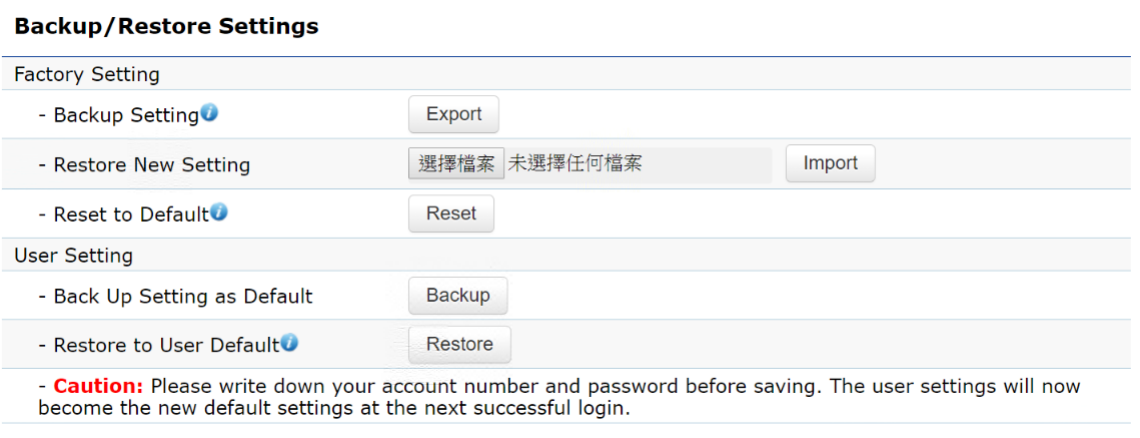
54
Backup/Restore
This page allows you to save the current device
configurations. When you save your configurations,
you also can reload the saved configurations into the
device through the Restore Saved Settings from a file
section. If extreme problems occur, or if you have set
the AP incorrectly, you can use the Reset button in the
Revert to Factory Default Settings section to restore
all the configurations of the AP to the original default
settings.
Backup Setting: Click Export to save the current
configured settings.
Restore New Setting: To restore settings that have
been previously backed up, click Browse, select the
file, and click Restore.
Restore to Default: Click Reset button to restore the
AP to its factory default settings.

55
User Setting
The function allows you to backup the current device
configurations into the AP as the default value. If
extreme problems occur, or if you have set the AP
incorrectly, you can push the Reset button to revert all
the configurations of the AP to the user default.
Back Up Setting as Default: Click Backup to backup
the user settings you would like to the device’s memory
for the default settings.
Restore to User Default:ClickRestore to restore user
settings to the factory standard settings.
Note1: After setting the current settings as the default, you should click the Restore to Default on the
web interface for reverting the settings into the factory default instead of pushing the reset button.
Note2: Please write down your account and password before saving. The user settings will now become
the new default settings at the next successful login.
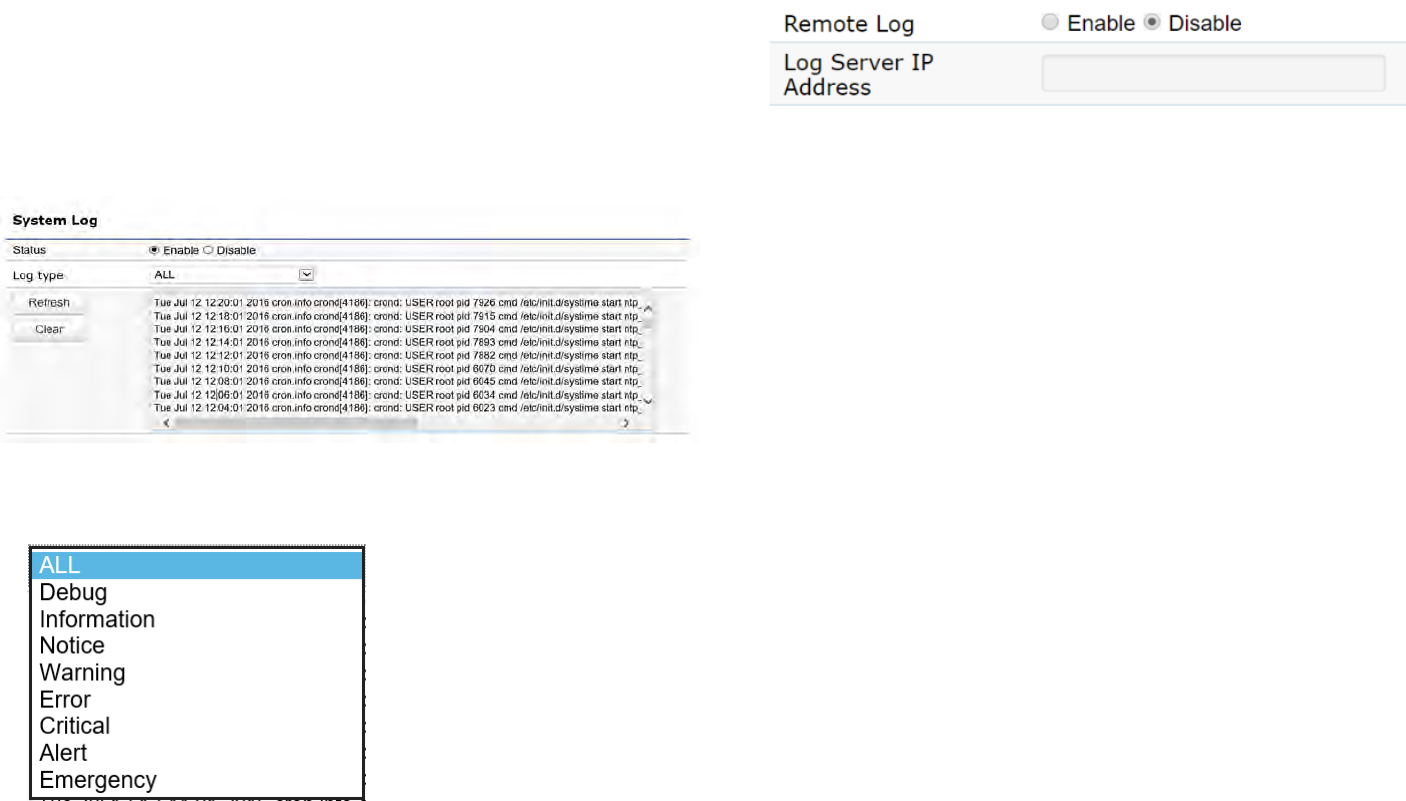
56
System Log
The AP automatically logs (records) events of possible
interest in its internal memory. To view the logged
information, click the Log link under the System Manager
menu. If there is not enough internal memory to log all
events, older events are deleted from the log. When
powered down or rebooted, the log will be cleared.
Status:Enable/Disablethisfunction.
Log type: You may choose one of log types to display logs
in the following window. The default log types is All.
Remote Log
This page allows you to setup the Remote Log functions
for this AP.
Remote Log:Enable/Disablethisfunction.
Log Server IP Address: Enter the IP address of the log
server.
Apply: Click Apply to apply the changes.
Log
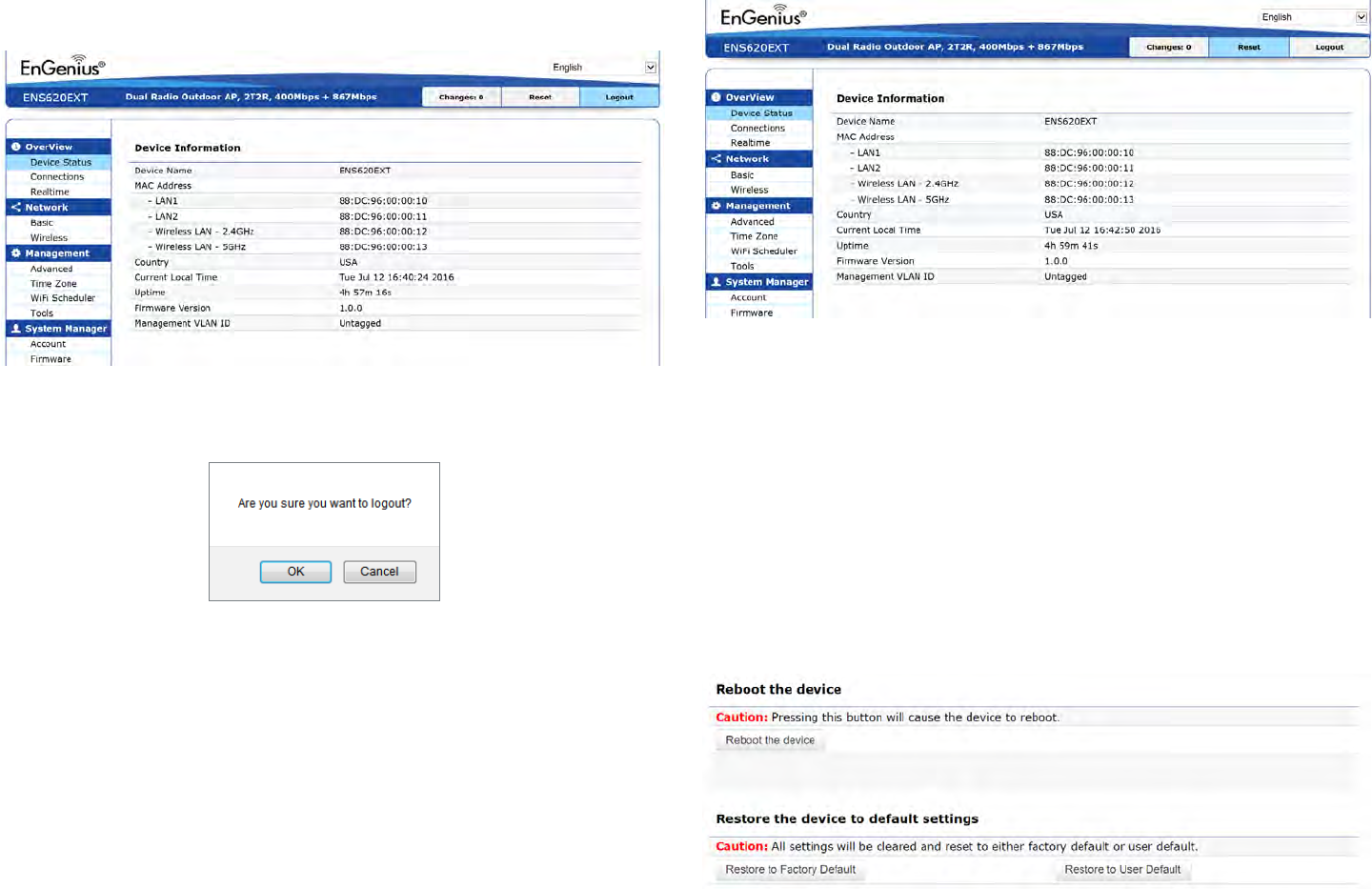
57
Logout
Logout: Click Logout in Management menu to logout.
Pleaseconrmagaintologoutthesystemornot.
Reset
In some circumstances, it may be required to force the
device to reboot. Click on Reset to reboot the AP.
Once you click reset button, you will see the options for
reboot or restore this AP.
Rebootthedevice:Clickittorebootthisdevice.
RestoretoFactoryDefault:Clickittoresetthisdeviceto
factory default setting.
RestoretoUserDefault:Clickittoresetthisdeviceto
user default settings.
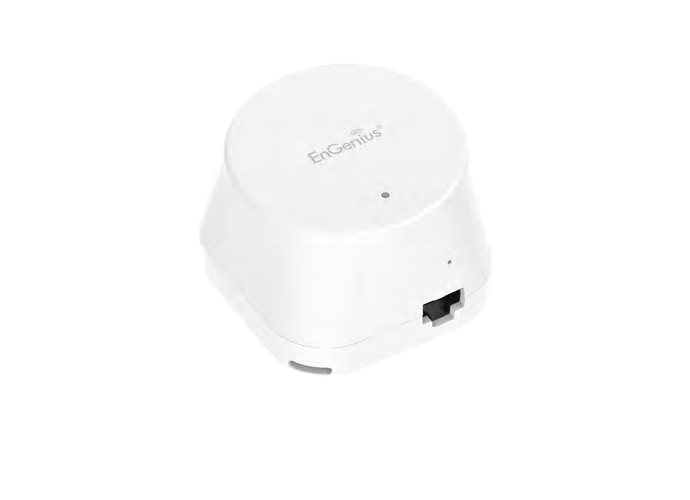
58
Appendix

59
Federal Communication Commission Interference Statement
This equipment has been tested and found to comply with the limits for a Class B digital device, pursuant to Part 15 of the FCC Rules. These limits are
designed to provide reasonable protection against harmful interference in a residential installation. This equipment generates, uses, and can radiate
radio frequency energy and, if not installed and used in accordance with the instructions, may cause harmful interference to radio communications.
However, there is no guarantee that interference will not occur in a particular installation. If this equipment does cause harmful interference to radio
or television reception, which can be determined by turning the equipment o and on, the user is encouraged to try to correct the interference by
one of the following measures:
• Reorient or relocate the receiving antenna.
• Increase the separation between the equipment and receiver.
• Connect the equipment into an outlet on a circuit dierent from that to which the receiver is connected.
• Consult the dealer or an experienced radio/TV technician for help.
FCC Caution:
Any changes or modications not expressly approved by the party responsible for compliance could void the user’s authority to operate
this equipment.
This device complies with Part 15 of the FCC Rules. Operation is subject to the following two conditions: (1) This device may not cause harmful
interference, and (2) this device must accept any interference received, including interference that may cause undesired operation.
IMPORTANT NOTE:
Radiation Exposure Statement
This equipment complies with FCC radiation exposure limits set forth for an uncontrolled environment. This equipment should be installed and
operated with a minimum distance of 20 cm between the radiator & your body.
This transmitter must not be co-located or operating in conjunction with any other antenna or transmitter. Operation of this device is restricted to
indoor use only.
Appendix A
60
Europe – EU Declaration of Conformity
This device complies with Directive 2014/53/EU issued by the Commission of the European Community.
- Declaration of Conformity
Please added certication standard in your user manual which depended on the test standards your device performed. or
- If the DoC should be a simplied version, please take below as reference –
Hereby, EnGenius Networks declares that the EMD2 is in compliance with Directive 2014/53/EU.
The full text of the EU declaration of conformity is available at the following internet address:
Importer: EnGenius Networks Europe B.V.
Importer Address: ESP 240, 5633 AC Eindhoven, The Netherlands
Manufacturer : EnGenius Networks. Inc.
Manufacturer Address: No.500, Fusing 3rd Rd., Hwa-Ya Technology Park Kuei-Shan Dist., Taoyuan City, Taiwan (R.O.C.)
Appendix B - CE Interference Statement